#royal danish ballet and music festival
Photo
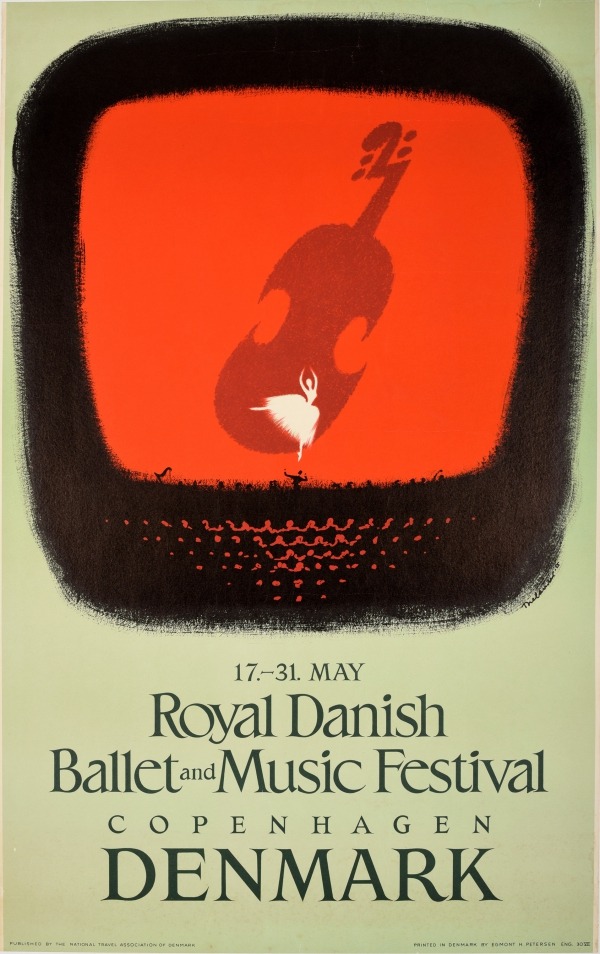
Poster for the Royal Danish Ballet and Music Festival held in Copenhagen, Denmark (c. 1950).
#vintage poster#denmark#1950s#royal danish ballet and music festival#ballet#music#copenhagen#danish#royal danish ballet#orchestra
74 notes
·
View notes
Text
Breaking down the Flower Festival in Genzano pas de deux by Bournonville and why I think it fits GerIta (🇩🇪♡🇮🇹)

━━━━━━━━━━━━━━━━━━━━━━━━━━⊱༺༻⊰━━━━━━━━━━━━━━━━━━━━━━━━━━
It's as the title says!
I am a ballet nerd, ballet is a special interest of mine so naturally I am currently mixing it with GerIta and today, I'll be breaking down a certain pas de deux and why I think it's basically GerIta. This is the first part though, I am also doing it on Twitter (if anyone wants to read it there, here) but I'll just copy and paste all I write there in here. Also, because some of the points I make use videos, please watch them on Twitter because I can't put them here on Tumblr lol.
Here we go!
━━━━━━━━━━━━━━━━━━━━━━━━━━⊱༺༻⊰━━━━━━━━━━━━━━━━━━━━━━━━━━
I'll be using this performance as reference because it's in HD and I think captures the storyline perfectly
First, some context.
Who in the world is Bournonville? 🤔
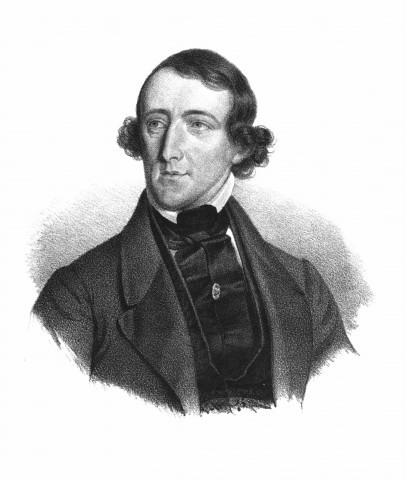
To make it short, he’s like the Da Vinci of ballet.
August Bournonville was a Danish ballet dancer who lived from 1805 to 1879. He was not only a dancer, but a choreographer, ballet teacher and director. His influence was huge, he created a whole ballet training method (named after him and still used in current Danish ballet schools and companies, such as the Royal Danish Ballet) and his contributions to the development of romantic ballet include his more than 50 ballets, with typically friendlier, more natural and humane characters and acting, plus the attention he put to make male dancers so they became as important as the female dancers.
One of his famous quotes is "dance is essentially an expression of joy" and this shows a lot in his choreographies. I won’t talk too much about him today, but if you’re curious I might make another thread talking about the Bournonville method and some other ballets he made because they are colorful and so gorgeous. 🛐
The background of the Flower Festival in Genzano. 🌼
It premiered in 1858 and it was danced exclusively by the Royal Danish Ballet, but after being dropped, most of the original ballet was lost except from the pas de deux, which is immensely popular as it showcases the Bournonville teaching method strengths perfectly (jumps, natural acting, among others). As for the name, I believe it refers to Genzano di Roma, a town in central Italy where in June, the Infiorata is held, an exhibition where people make carpets of flowers and a masked parade walk on them wearing medieval and traditional clothes made by the town's women. It is well known that Danish, Germans and northern europeans in general had a fascination with Italy, which is why Bournonville made another ballet based on Italy called Napoli, which serves as a predecessor to Flower Festival. This pas de deux was originally from an Austrian production of Napoli and Bournonville liked it so much he said "mine now." 👌
The pas de deux. 🩰
I am not going to talk about the music itself (made by by Edvard Helsted and Holger Simon Paulli), only about the choreography, but it has to be noted that they also worked on another of Bournonville's great ballets, Napoli, and I absolutely ADORE their work. Bournonville’s choreographies have a lot of musicality and every step is accentuated by the music, so it’s a joy to watch, but just listening to the whole pas de deux is a guarantee Good Vibe. It’s about 9 minutes long, but it’s so sweet and soft,,
Okay, so back to the ballet itself. We are greeted by a cute couple of young lovers (for me, the girl is Feli and the boy is Lud, so read what I’m saying with that in mind) just walking through flower fields.
The acting is natural instead of the more poised and solemn acting other famous ballet characters have. They are comfortable and don’t over-act even in the context of ballet, they feel like what they are described as in the first seconds of the pas de deux: a shy young couple.

Holding hands at first, he takes her hand so she can hug his arm and then he does this mime where he points at her, then to the ground and waves his hands. This mime basically means "dance for me". A romantic and cliché way to begin a pas de deux, but it's iconic so it's ok.
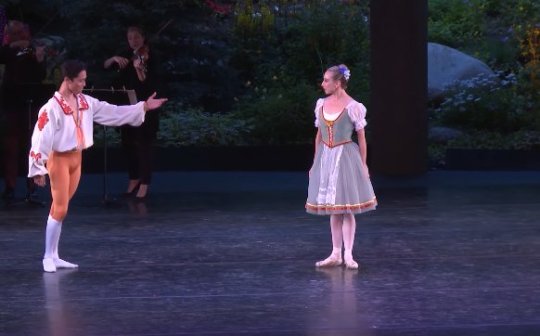
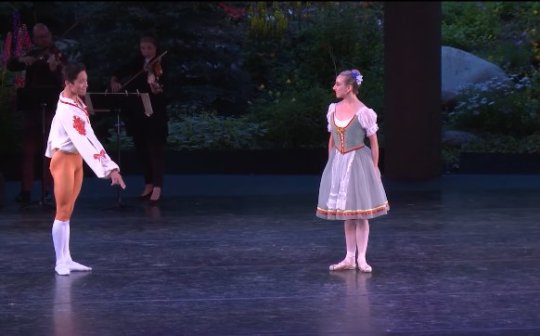
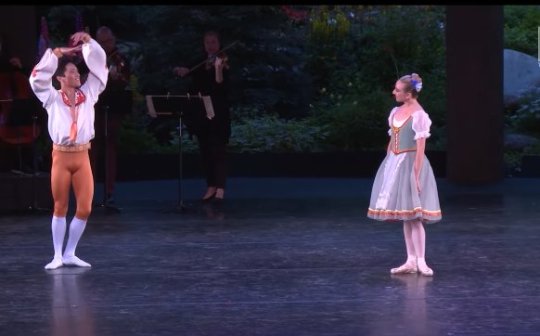
She bows and accepts and then they both greet the musicians, which is a cute detail not present in most pas de deux. I think it's cute. 💕
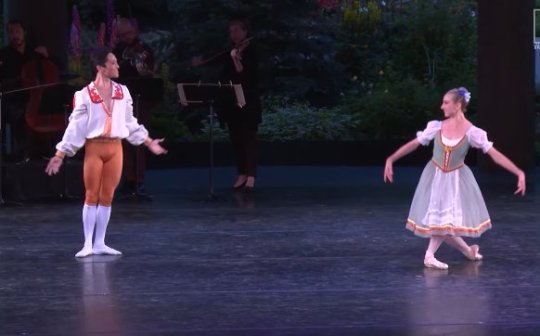
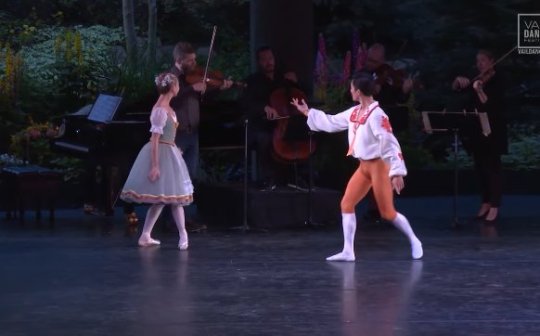
Now you have the floor, m'lady. 💃🕺
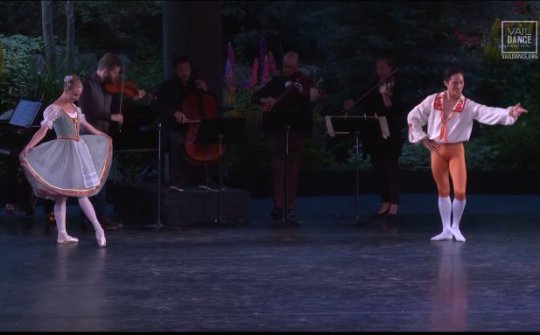
I will save y'all the mention of every single step because it would take a lot of time, but this one in particular is called cabriole and it's harder than it looks, but the she still makes it look effortless and bouncy. She's happily dancing for her beloved. 💖


She's a very vibrant girl, youthful and cheerful unlike some other tragic heroines like Odette or Nikiya, I think her bubbly personality fits Feli perfectly. He looks so enamoured and proud, these two dancers (Isabella Boylston and Jeffrey Cirio) portray the characters so well,,

And he decides to join her because he loves her and what kind of man would reject a chance to dance with his beloved? As stated previously, Bournonville was a male dancer and thus, he put the male dancers on the spotlight just as much as female dancers, so we start off strong.

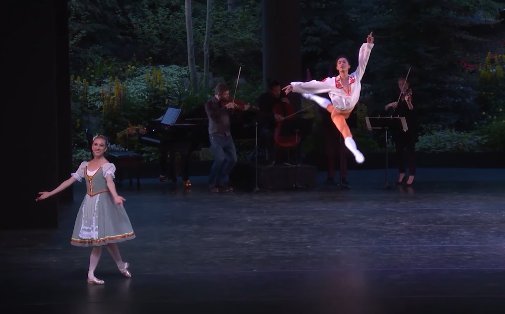
I love her acting here, like she asks "omg what are you doing". She stops in her tracks and watches her boyfriend with awe.
In my Delusions, I think Feli would be really surprised to see Lud dance because he is shy and a dork, but of course he would also be happy! Me too tbh😭💖
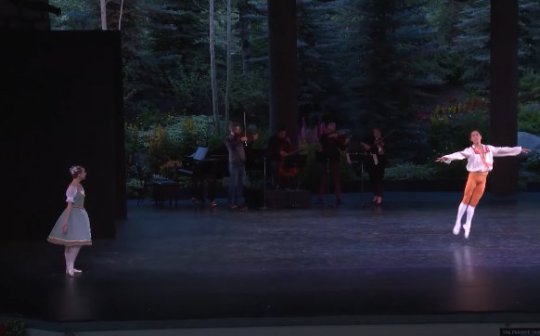
This step right here is iconic to Bournonville, especially with the male dancers. It's called a batterie, you jump and beat your legs slightly and quickly and it's much harder than it looks, but as always, he makes it look light and effortless. And I know I wasn't going to talk about the music but God I love the violin here, it's so bubbly and cute and the way the batterie goes along with the melody is so nice. 😭 You cannot divorce ballet from the music!
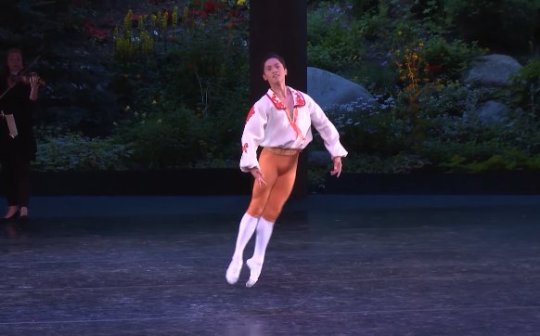
A very high jump from a very strong dancer, he looks at her and invites her to join him, increasingly happier as he dances. "Aw, why did you stop?" I can hear him saying.

A detail that I realized after watching some other ballet dancers talking about this is the fact that in most ballet (classical, because that's what I like the most) male dancers aren't usually that expressive. They have variations showcasing their technique and stamina, but in the artistic department it's the female dancers who usually shine. Not to say that classical male roles aren't expressive, but it's the girls who usually have a wider range to act and express the characters. Male dancers are often pushed to the "elegant prince role" or the peasant man, but they don't usually smile as wide as this character and I think it's a nice change! Male ballet dancers don't usually wear pointe shoes either, but it's starting to change and I hope soon we can get more diversity with productions.
Coming back to my Delusion, I have written a GerIta ballet AU (here's some shameless self-advertise https://archiveofourown.org/works/55068460) and I like to imagine that, as always, Ludwig has difficulties expressing himself in True Neurotypical Fashion, but to think that in the role of a young foolish lover he can somehow express that soft side of his makes me incredibly happy, especially because as someone who's autistic, I find expressing my feelings through art much easier especially towards the ones I love. Some shameless projection here too, I suppose. 🧐
And a flawless pirouette (I think I counted four turns omg), because of course, this is ballet. 🛐
Most male choreographies end their pirouettes dramatically, but in this one he's a simple young peasant man so he has no need for flashy poses. He gets the job done with a smile.
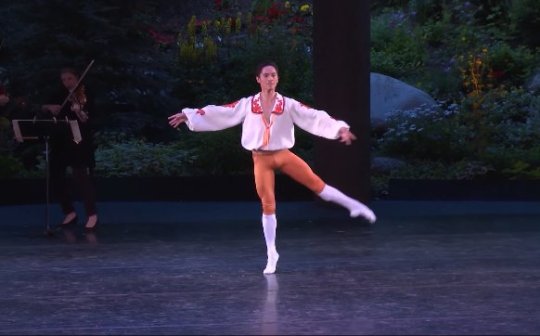

"Your turn, liebling"
"😌"

The characterizaton here is superb, I love how clearly you can see the storyline and how humane the characters are. Just youngsters playing around, being silly and loving,,
"Wait, where are you going?" He says. 😟
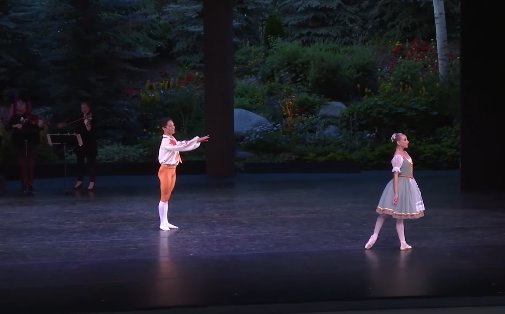
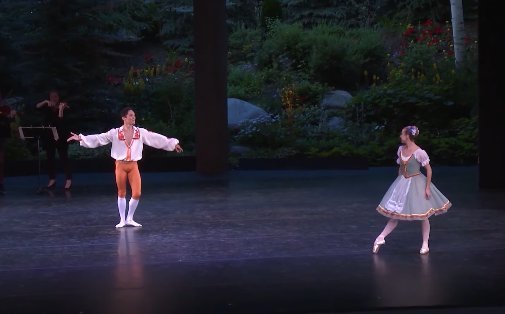
She's just teasing him and of course, with my Delusion, I can totally see this as Them. I like when their relationship gradually becomes so close and tender Feli just takes the liberty to tease Lud🥹
The girl tilts her head and you can practically picture her mischievous smile.

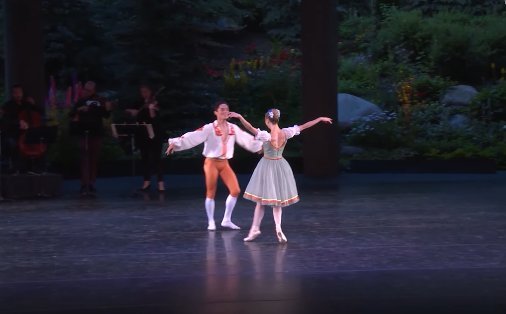
This next part is fascinating to me (video here). It's 1875, Bournonville liked this so much he made a divertissement to keep the pas de deux in which, unlike literally every other ballet, it's the guy who does the promenade instead of the girl (+ how look at each other in the end it's so cute 😭)
A promenade it's a difficult step in which you turn around over one single leg. Normally, it's ballerinas who do it with the male dancer suporting them. Wearing pointe shoes makes it easier because he is the one moving you, but in this case he is the one turning while still holding her. The roles are reversed! And they look so lovingly into the eyes of the other, God this is so cute. 💖
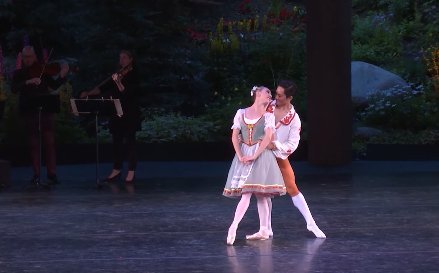
This step is called penché and I really like it, it's iconic to ballets such as Swan Lake, but in here it is done with the shoes flat instead of pointed. It's a Bournonville thing. 👌
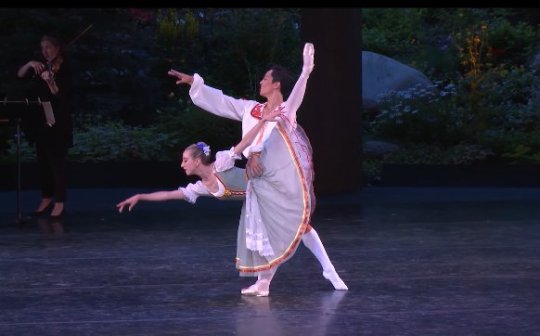
This pose right here is so pretty omg. She looks so shy, like she doesn't want to look at him out of bashfulness,,, so cute,,,, I like to take screenshots of poses like this to study and redraw, so I am definitely doing this one someday. Mark my words.🫡
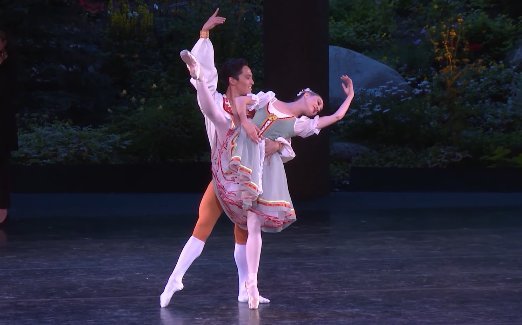
He extends her hand to her and she takes it gleefully. The way she pulls him over with a smile so they dance together screams Feli to me. It's something I can totally see him doing, pulling Ludwig over to dance some steps that really highlight that awkward shyness they have, looking away from each other and chuckling,, it's so them😭 (video here)
I swear I love this part because it's so well characterized, it has so much personality and it's so sweet 😭😭💕💕 Bournonville really nails that "young lovers" part with playful but somewhat shy acting, it's so cute.
Here, he finally gathers enough courage and declares his love for her, kneeling down and everything, but she's like "mhm, really?" ignoring him and walking away. He's then saddened but she turns around with a bright smile, saying she was just joking and that she loves him too.
I can totally see Feliciano joking with Ludwig like that once they grow closer and closer, but maybe that's just me. He doesn't mean anything bad like that, he's just teasing him!
He would be a little brattish and go "just kidding😋"

Another beautiful pose, the way he looks at her says everything. He's smitten 🙏
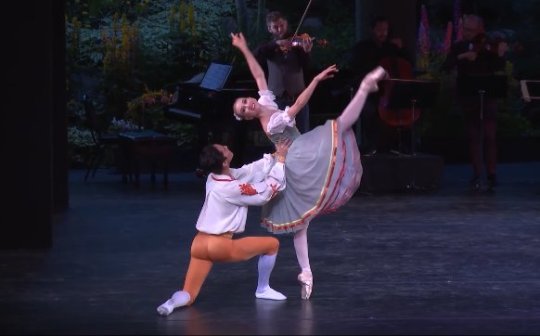
And this is all I have for now, thank you for reading! Tomorrow I'll keep going but for now, please think of them. As for me, I am imagining them in my ballet AU where for some reason, they end up dancing this piece right here! So cute orz 💖💖💖💖💖
#hws gerita#gerita#aph gerita#ballet au#just rambling#this is for ship and brainrot purposes#and to make sure i don't lose all this thought i put in here#i didnt know tumblr had a limit for images#i had to cut off some#but it was still fun! i hope you enjoyed!
7 notes
·
View notes
Text
2021 Praemium Imperiale Awards
2021 Praemium Imperiale Awards, Architecture Laureate, Architect, Japan Art Association Award Winners, News
2021 Praemium Imperiale Awards News
14 Sep 2021
2021 Praemium Imperiale Awards
The Japan Art Association and Lord Patten of Barnes, Praemium Imperiale’s International Advisor in the UK, have today announced the recipients of the 2021 Praemium Imperiale Awards:
Painting: Sebastião SALGADO (France/Brazil)
photo © The Japan Art Association / Shun Kambe
Sculpture: James TURRELL (USA)
photo © The Japan Art Association / Yutaka Sato
Architecture: Glenn MURCUTT (Australia)
photo © Anthony Browell
Music: Yo-Yo MA (USA)
(USA)
Yo-Yo Ma performing in Mumbai, India, as part of the Bach Project (2019) © Austin Mann
Each Laureate receives an honorarium of 15 million Yen (c. £100,000). The awards are given by the Japan Art Association under the honorary patronage of His Imperial Highness Prince Hitachi, younger brother of the Emperor Emeritus of Japan. In addition to the Praemium Imperiale Awards, the 5 million Yen (c. £33,000) Grant for Young Artists has been awarded to The Central Institute for Restoration, founded in 1939 with the aim of conserving and restoring Italy’s cultural and artistic heritage, threatened at the time by the outbreak of the Second World War. The Grant will fund 30 student research projects.
The internationally renowned photographer Sebastião Salgado will be the subject of a major exhibition at London’s Science Museum this autumn (13 October 2021 – March 2022). The series of 200 breath-taking black and white photographs are drawn from his latest work, Amazônia, a seven-year study of the Amazon ecosystem and the way of life of its indigenous people.
The book, Amazônia, was published in May this year. Salgado and his wife Lélia moved to France in 1969 as political refugees from Brazil. Initially trained as an economist, he took up photography full time in 1973. He works thematically, using only natural light, his photos posing serious questions about the imbalance of wealth and the impact of wars and disasters. Since the 1990s, he has been actively involved with environmental and reforestation issues through the Instituto Terra organisation that he and his wife established in his home in Brazil.
Lord Patten remarked: ‘Hot on the heels of the Tokyo Olympics and Paralympics that captured the world’s imagination, this year’s Praemium Imperiale serves as an opportune reminder of the important contribution that Japan has made in honouring achievement in the arts. As artists and cultural organisations around the world begin to recover from the devastations of the past 18 months, I hope this year’s laureates and their important contribution to civilisation will be a source of inspiration for fellow artists, governments and arts lovers.’
Since 1989, the Praemium Imperiale Awards have been given annually in the categories drawn from Painting, Sculpture, Architecture, Music and Theatre/Film to cover fields of achievement not represented by the Nobel Prizes. The Laureates are selected from a list submitted by six International Advisors to the Japan Art Association.
While maintaining the Awards’ original mandate to select candidates who have made a major international impact in their particular field, the International Advisors for the Awards and their committees have been looking beyond their national boundaries for ground-breaking artists to recommend to the Japan Art Association. Former Prime Minister of Japan Shinzo Abe has been appointed the latest International Advisor, presiding over the Asian Nomination Committee. He succeeds the late former Prime Minister Yasuhiro Nakasone who passed away in November 2019.
Arthur and Yvonne Boyd Education Centre, 1996 – 99, NSW, Australia © Anthony Browell, Courtesy of TOTO Publishing
• £400,000 award given by the Japan Art Association under the honorary patronage of His Imperial Highness Prince Hitachi, younger brother of the Emperor Emeritus of Japan
• The Advanced Training School of the Central Institute for Restoration (Italy) receives Grant for Young Artists
• Former Prime Minister of Japan Shinzo Abe to become International Advisor to the Award, presiding over the Asian Nomination Committee
Previous British winners include David Hockney, Mona Hatoum, Anish Kapoor, Antony Gormley, Norman Foster, Richard Rogers, David Chipperfield, Judi Dench, Anthony Caro and Tony Cragg.
Walsh House, 2001 – 05 NSW, Australia © Anthony Browell, Courtesy of TOTO Publishing
2021 Praemium Imperiale Awards images/information received 140921
Previously on e-architect:
Praemium Imperiale Architecture Laureate Past Winners
13 Sep 2016
Paulo Mendes da Rocha wins Praemium Imperiale 2016 for Architecture
The Japan Art Association has today announced the recipients of the 2016 Praemium Imperiale Awards:
Praemium Imperiale 2016 for Architecture
Architect Dominique Perrault wins Praemium Imperiale 2015 for Architecture
Praemium Imperiale 2015 for Architecture
17 Sep 2013
David Chipperfield wins Praemium Imperiale 2015 for Architecture
Architectural Laureate of the Praemium Imperiale 2013
photo © Nick Knight
David Chipperfield is announced as the Architectural Laureate for the 2013 edition of the Japan Art Association’s Praemium Imperiale. The award will be presented by HIH Prince Hitachi, brother of Emperor Akihito, at a ceremony in Tokyo on 16 October 2013.
David Chipperfield Architect
12 Sep 2012
Henning Larsen wins Praemium Imperiale Architecture Laureate 2012
PRAEMIUM IMPERIALE AWARDS 2012 ANNOUNCED
Today, The Japan Art Association announced the names of this year’s Praemium Imperiale Laureates:
Painting: Cai Guo-Qiang
Sculpture: Cecco Bonanotte
Architecture: Henning Larsen
Music: Philip Glass
Theatre/Film: Yoko Morishita
The Praemium Imperiale is a global arts prize awarded annually by the Japan Art Association. Now in its 24th year, since its inauguration in 1989 it has become a mark of the highest international distinction for achievement in the arts. The awards honour individuals from all over the world who have made an outstanding contribution to the development of the arts and are made in five categories – Painting, Sculpture, Architecture, Music and Theatre/film.
photo : Agnete Schlichtkrull
The awards will be presented by Prince Hitachi, Honorary Patron of the Japan Art Association, the younger brother of the Emperor of Japan, at a ceremony in Tokyo in October. Each Laureate will receive an honorarium of 15 million yen (c. £115,000), a diploma and a medal – making the Awards globally the most substantial.
The list of major artists selected this year includes Cai Guo-Quiang, the brilliantly innovative Chinese artist who created the memorable ‘Footprints in the Sky’ works for the opening ceremony of the Beijing Olympics – so appropriate for this Olympic year. He is the first Chinese Praemium Imperiale Laureate.
Henning Larsen
image from architects
Henning Larsen, the great Scandinavian architect responsible for so many outstanding, light-filled buildings both in his native Scandinavia but also in the Middle East, is another first – the first Danish Laureate for Praemium Imperiale.
This year, the Music Category has been given to Philip Glass – one of the most influential composers of the modern period and well known to many for his collaborations with musicians as diverse as Ravi Shankar, David Bowie, Brian Eno and Leonard Cohen.
The Japanese ballet dancer, Yoko Morishita in the category of Theatre/Film and the Italian sculptor, Cecco Bonanotte in the category of Sculpture further emphasis the rich diversity of these awards.
Lord Patten of Barnes, UK’s International Advisor to the Praemium Imperiale Awards says, “ it is fitting that, in this Olympic year, one of the artists who contributed so much to the Beijing Olympics be honoured. But let’s not forget that Anish Kapoor and Zaha Hadid who have made a major impression on the London Olympics, are also members of the very exclusive club of past Praemium Imperiale Laureates (Anish Kapoor 2011 and Zaha Hadid 2009)”.
Praemium Imperiale Architecture Laureate Archive
Ricardo Legorreta wins Praemium Imperiale in 2011
photograph of Ricardo Legorreta from B&Q
Praemium Imperiale 2011
architect Ricardo Legorreta
Toyo Ito wins Praemium Imperiale Architecture Laureate for 2010
photograph © 2007 Deborah Bullen
Praemium Imperiale 2010
architect Toyo Ito
Zaha Hadid wins Praemium Imperiale Architecture Laureate for 2009
picture from architects
Praemium Imperiale 2009
architect Zaha Hadid
Location: Tokyo, Japan, Asia
Praemium Imperiale – Background Information
Praemium Imperiale
The Praemium Imperiale was established in 1988 to mark the centennial of the Japan Art Association and to honour the wish of the late Prince Takamatsu, its Honorary Patron for 58 years, “to contribute to enhancing and promoting the cultures and arts of the world”. As well as honouring five international artists each year, it also gives a grant to a Young Artists group, who nurture young talent.
Japan Art Association
The Japan Art Association is the oldest cultural foundation in Japan, established in 1887. It runs the Ueno Royal Museum in Tokyo, and organizes and holds art exhibitions. Prince Hitachi, younger brother of the Emperor, has been its Honorary Patron since 1987. The Association has presented five Praemium Imperiale Awards every year since 1989.
Architecture Awards
Pritzker Prize architects
Stirling Prize
Architect Offices
Sustainable Architecture
World Architecture Festival Awards
RIBA Royal Gold Medal
Interiors
Comments / photos for the Praemium Imperiale Architecture Laureate News – 2020 Awards Postponement page welcome
Website: www.praemiumimperiale.org
The post 2021 Praemium Imperiale Awards appeared first on e-architect.
0 notes
Text
A Night at the Opera: Rigoletto (Copenhagen 2017)
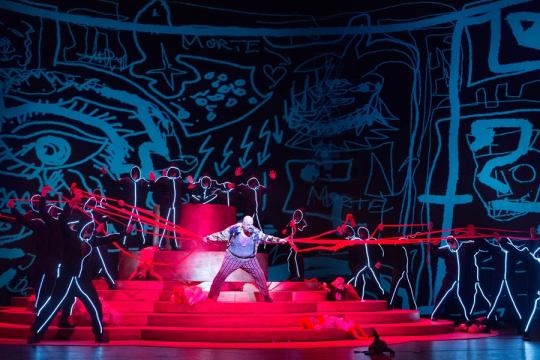
Last year I had the good fortune to see a production of Verdi’s famous opera Rigoletto at the Royal Danish Opera in Copenhagen that was nothing short of pure genius!
It was a truly amazing production that used the stage-setting and direction to really challenge the story critically, inviting for the audience to read the story against the grain by opening up a subtle narrative space for the creation of counter-stories.
youtube
It addressed some of the darker aspects of the story, especially in regard to the relationship between Rigoletto and his daughter Gilda - aspects that relates to gender and sexuality. I was immensely pleased by this since these are aspects of the story that I’ve always found very troubling. Furthermore, the way that Gilda decides to sacrifice her life to save her unfaithful lover has never sat right with me - so it was great to experience a production that engaged critically with these particular aspects of the story.
Historical Background
Rigoletto is an opera created by the renowned Italian composer Guiseppe Verdi and it is based on the play Le roi s’amuse from 1832 by the French author Victor Hugo. The play takes place in Paris in the early 1500s and features the libertine renaissance king Francois I. The protagonist is the court jester Triboulet who encourages the king in his vices.
In his preface to the play, the author notes that Triboulet "hates the king because he is king; hates the nobles because they are nobles and hates men because they don't all have a hump-back... he corrupts the king and brutalizes him, urging him on to tyranny, ignorance and vice, dragging him through the gentlemen's families, pointing out a woman to seduce, a sister to kidnap, a girl to dishonour...". (x)
The play was considered a thinly veiled attack on King Louis-Phillipe and was banned after just one performance.
In 1850 Verdi was commissioned by to write an opera for La Fenice in Venice. Verdi chose Victor Hugo’s controversial play to adapt into an opera because of the grand, tragic subject and the character of Triboulet. However, it was a controversial choice and he got into trouble with the Austrian Board of Censors (Austria had control over Northern Italy at the time). Verdi and his librettist reworked the story with significant changes. The story was now set in Mantua, the king was made into a duke and the hunchbacked jester was renamed Rigoletto. The opera premiered in Februrary 1851 and has since become one of Verdi’s most famous and beloved operas.
The Story
ACT 1
Scene 1: A room in the palace of Duke of Mantua
At a ball in his palace, the Duke sings of a life of pleasure with as many women as possible. He has seen an unknown beauty in church and desires to possess her, but he also wishes to seduce the Countess of Ceprano. Rigoletto, the Duke's hunchbacked court jester, mocks the husbands of the ladies to whom the Duke is paying attention, including the Count Ceprano, and advises the Duke to get rid of him by prison or death. The Duke laughs indulgently, but Ceprano is not amused.
Marullo, one of the guests at the ball, informs the courtiers that Rigoletto has a "lover", which astonishes them. The courtiers resolve to take vengeance on Rigoletto for making fun of them. The festivities are interrupted by the arrival of the elderly Count Monterone, whose daughter the Duke had seduced. Rigoletto provokes him further by making fun of his helplessness to avenge his daughter's honor. Monterone confronts the Duke, and is immediately arrested by the Duke's guards. Before being led off to prison, Monterone curses Rigoletto for having mocked his righteous anger. The curse terrifies Rigoletto, who believes the popular superstition that an old man's curse has real power.
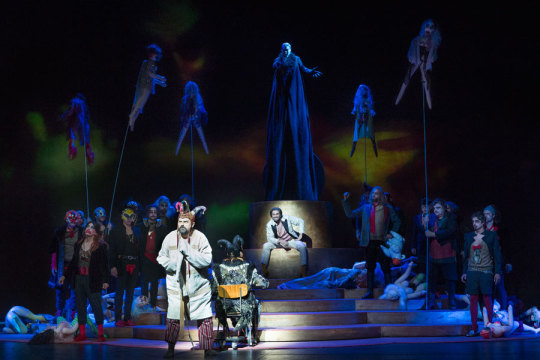
(Count Monterone curses Rigoletto)
Scene 2: A street, with the courtyard of Rigoletto's house
Preoccupied with the old man's curse, Rigoletto approaches his house and is accosted by the assassin Sparafucile, who walks up to him and offers his services. Rigoletto declines for the moment, but leaves open the possibility of hiring Sparafucile later, should the need arise. Sparafucile wanders off, after repeating his own name a few times. Rigoletto contemplates the similarities between the two of them; Sparafucile kills men with his sword, and Rigoletto uses "a tongue of malice" to stab his victims.
Rigoletto opens a door in the wall and returns home to his daughter Gilda. They greet each other warmly. Rigoletto has been concealing his daughter from the Duke and the rest of the city, and she does not know her father's occupation. Since he has forbidden her to appear in public, she has been nowhere except to church and does not even know her own father's name.
When Rigoletto has gone, the Duke appears and overhears Gilda confess to her nurse Giovanna that she feels guilty for not having told her father about a young man she had met at the church. She says that she fell in love with him, but that she would love him even more if he were a student and poor. As she declares her love, the Duke enters, overjoyed. Gilda, alarmed, calls for Giovanna, unaware that the Duke had sent her away. Pretending to be a student, the Duke convinces Gilda of his love. When she asks for his name, he hesitantly calls himself Gualtier Maldè. Hearing sounds and fearing that her father has returned, Gilda sends the Duke away after they quickly trade vows of love. Alone, Gilda meditates on her love for the Duke, whom she believes is a student: "Gualtier Maldè!... Caro nome" ("Dearest name").
Later, Rigoletto returns, while the hostile courtiers outside the walled garden (believing Gilda to be the jester's mistress, unaware she is his daughter) get ready to abduct the helpless girl. They tell Rigoletto that they are actually abducting the Countess Ceprano. He sees that they are masked and asks for a mask for himself; while they are tying the mask onto his face, they also blindfold him. Blindfolded and deceived, he holds the ladder steady while they climb up to Gilda's room.

(The courtiers abduct Gilda)
With her father's unknowing assistance Gilda is carried away by the courtiers. Left alone, Rigoletto removes his mask and blindfold, and realizes that it was in fact Gilda who was carried away. He collapses in despair, remembering the old man's curse.
ACT 2
The Duke's Palace
The Duke is concerned that Gilda has disappeared. The courtiers then enter and inform him that they have captured Rigoletto's mistress. By their description, he recognizes it to be Gilda and rushes off to the room where she is held. Pleased by the Duke's strange excitement, the courtiers now make sport with Rigoletto, who enters singing. He tries to find Gilda by pretending to be uncaring, as he fears she may fall into the hands of the Duke. Finally, he admits that he is in fact seeking his daughter and asks the courtiers to return her to him. Rigoletto attempts to run into the room in which Gilda is being held, but the courtiers block the way. Gilda enters. The courtiers leave the room, believing Rigoletto has gone mad.
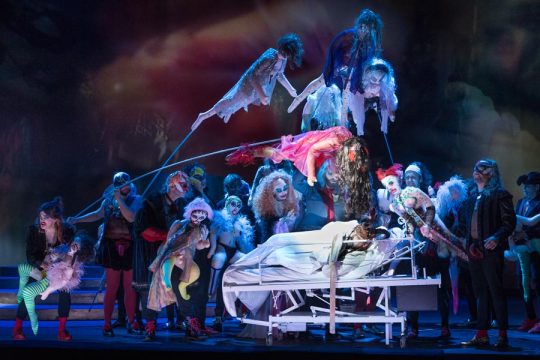
(The courtiers mock Rigoletto)
Gilda describes to her father what has happened to her in the palace. In a duet Rigoletto swears vengeance against the Duke, while Gilda pleads for her lover.
ACT 3
A street outside Sparafucile's house
A portion of Sparafucile's house is seen, with two rooms open to the view of the audience. Rigoletto and Gilda arrive outside. The Duke's voice can be heard from inside, singing "La donna è mobile" ("Woman is fickle"). Sparafucile's sister, Maddalena, has lured him to the house. Rigoletto and Gilda listen from outside as the Duke flirts with Maddalena. Gilda laments that the Duke is unfaithful; Rigoletto assures her that he is arranging revenge: "Bella figlia dell’amore" ("Beautiful daughter of love"). Rigoletto orders Gilda to put on a man's clothes to prepare to leave for Verona and tells her that he plans to follow later. After she leaves, he completes his bargain with the assassin, who is ready to murder his guest for 20 scudi. Rigoletto then withdraws.
With falling darkness, a thunderstorm approaches and the Duke decides to spend the rest of the night in the house. Sparafucile directs him to the ground floor sleeping quarters, resolving to kill him in his sleep. Gilda, who still loves the Duke despite knowing him to be unfaithful, returns dressed as a man and stands outside the house. Maddalena, who is smitten with the Duke, begs Sparafucile to spare his life. Sparafucile reluctantly promises her that if by midnight another victim can be found, he will kill the other instead of the Duke.

(Gilda overhears Sparafucile promise his sister to kill a random stranger instead of the Duke)
Gilda, overhearing this exchange, resolves to sacrifice herself for the Duke, and enters the house. Sparafucile stabs her and she collapses, mortally wounded. At midnight, when Rigoletto arrives with money, he receives a corpse wrapped in a sack, and rejoices in his triumph. Weighting it with stones, he is about to cast the sack into the river when he hears the voice of the Duke, sleepily singing a reprise of his "La donna è mobile" aria. Bewildered, Rigoletto opens the sack and, to his despair, discovers his dying daughter. For a moment, she revives and declares she is glad to die for her beloved. She dies in his arms. Rigoletto cries out in horror. [synopsis borrowed from Wikipedia]
The Production
Rigoletto is a wonderful opera, a story of high tragedy expressed through gorgeous music. It features some of the most well-known arias in the world such as “La donna é mobile” and “Caro nome” as well as my personal favorite: the maginificent quartet “Bella figlia dell’amore”.
Whenever a classic piece of theatre, ballet or opera is put on the stage, the question often revolves around two choices: 1) a traditional production or 2) a modern interpretion. While I have enjoyed traditional productions of operas such as Tosca, La Bohème and La Traviata, I generally prefer “modernized” productions of the classics as these tend to engage critically and creatively with the material in a way that traditional productions rarely do. Fortunately, the Chilean-German director and scenographer Aniara Amos has chosen to stage this production in a modern and visually arresting manner.
Aniara Amos has chosen a rather bold strategy by telling the story after the fact. The opera opens with Rigoletto as a broken man, confined to a mental asylum, bedridden and strapped into a straitjacket. The story that unfolds before our eyes takes place entirely in Rigoletto’s broken mind, which is reflected in the both the stage-setting and the costumes. Everything is garish and distorted.
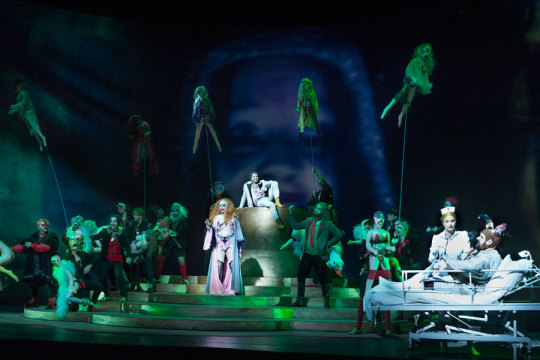
(Party at the palace of the Duke of Mantua)
The remembered events take on a nightmarish cast and the characters surrounding him are either caricatures or faceless automatons hidden behind masks. He is trapped in a nightmare of his own making.
Producing a Counter-Story
This narrative gambit opens up a space for the audience to read the story against the grain, to create their own counter-stories. It is a stroke of pure genius because it introduces an element of uncertainty into the narrative. The story that unfolds before our eyes suddenly becomes suspect because we cannot trust Rigoletto’s memories. He’s in a mental institution because he’s had a complete break-down so it is very possible that he rewrites events due to his psychological trauma.
Since the story takes place entirely in Rigoletto’s mind - as a mix of memories and a fiction - all the characters are in a sense facets of his broken psyche. This opens up for a much darker interpretation of one of the core aspects of the story: his relationship with his daughter Gilda.
Rigoletto is a character whose tragedy is entirely of his own making. He is, in a sense, a Tragic Hero who is undone by his own flaws - and he generally invokes both pity and fear. Rigoletto’s fatal flaws are his hatred of the nobility and his idealization of his daughter.
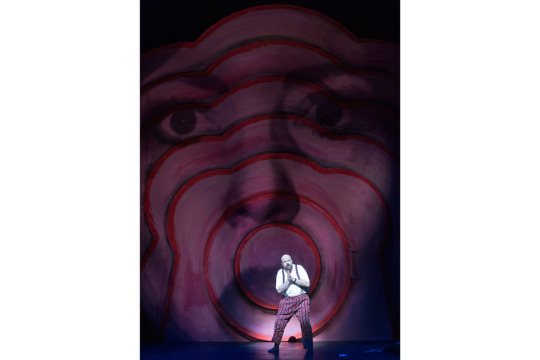
He gets a perverse pleasure from corrupting the Duke, egging him onto a path of dissolution and debauchery. He mocks the courtiers, which makes him enemies. However, there’s another side to his personality. He lives a kind of double-life as a cynical jester and as a doting father. He tries to keep the two spheres of his life completely separate and the tragedy occurs when the two spheres meet. He strives to keep his daughter Gilda completely innocent of the more dangerous and sordid aspects of life - but that also means that she has no defense against a practiced seducer like the Duke. Rigoletto is essentially the author of his own tragedy and that is part of what makes his story so poignant.
SEXUAL PURITY AND THE IDEAL OF WOMANHOOD
There is, however, an aspect of the story that has always annoyed me: the character of Gilda. She has never felt like a “real” character to me but rather a slightly modified version of The Angel in the House:
The popular Victorian image of the ideal wife/woman came to be "the Angel in the House"; she was expected to be devoted and submissive to her husband. The Angel was passive and powerless, meek, charming, graceful, sympathetic, self-sacrificing, pious, and above all--pure. (x)
Gilda isn’t really a person in this story but rather the embodiment of a very pernicious model of ideal womanhood; an ideal that is embedded in the culturally pervasive Madonna-Whore Complex, which can be described as:
The tendency for men to not be able to integrate the "dualisms" of women. Though EACH and EVERY female IS in fact fully capable of BOTH, it appears man's greatest challenge is to resolve them both in the same woman, thus these two aspects of the female must be relegated into two very separate and distinct categories--one or the other, black or white, Madonna or Whore. (x)
Gilda is so overwhelmingly angelic in her purity and kindness that she willingly sacrifices her life for a cheating douche that she has know for about 5 minutes. She’s an ideal instead of a fully fleshed out character and that is why it is difficult to connect with her character. This may not have been much of a problem for a Victorian audience but for a modern one, she is utterly incomprehensible.
Aniara Amos’ production addresses this particular aspect explicitly through the stage-setting and the direction of the singers - and it is the narrative gambit of letting the story play out in Rigoletto’s mind that makes a critical exploration of patriarchal gender norms and sexual mores possible. It is an approach that cast the relationship between Rigoletto and his daughter in a much darker light.
PRISONER IN ALL BUT NAME
One troubling aspect of the story is the fact that Gilda is not allowed to go outside unless it is to attend church. She has no idea of her father’s profession and she doesn’t even know his name! Neither will he tell her anything about her mother. She is kept in complete ignorance of everything apart from the teachings of the Church.
Aniara Amos emphasizes this troubling aspect of Rigoletto’s relationship with Gilda but having her literally locked up in a vault in his home. There’s also a degree of infantilization at play that is underscored by her costume, which is more suitable for a little girl than a young woman.
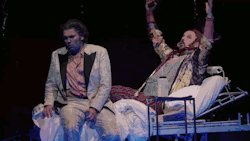
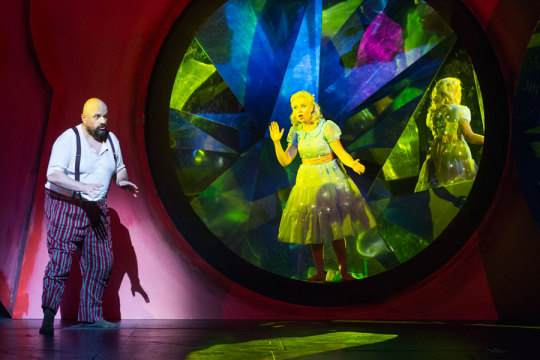
Since the story takes place in Rigoletto’s tortured mind, Gilda is not really a “person” but rather Rigoletto’s idealized memory of her. She is his little doll that he takes out to play house with - and the direction of the singers wonderfully subverts the image of Rigoletto as a loving and doting father by having him turn Gilda on and off with a remote control! The soprano’s robot-like movements supports this doll-like quality.
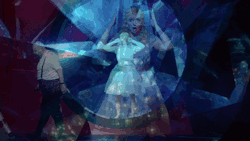
There’s something incredibly twisted and sinister about the relationship between Rigoletto and Gilda that this production highlights. Gilda is less like a daughter and more like an object to Rigoletto. She is his prized possession, locked up in a vault for safe-keeping and he is the only man that has access to her - until the Duke finds her at home.
I have already stated that Gilda is written as the embodiment of a historically specific ideal of womanhood: the meek, self-sacrificing and “pure” Angel in the House. However, the narrative gambit of having the story take place entirely in Rigoletto’s broken mind changes the inter-personal dynamics between the characters because all of the characters are reflections of Rigoletto himself in this particular set-up. If Gilda represents Rigoletto’s idealized view of his daughter, then what does the figure of the Duke represent? This is where the story gets really uncomfortable because if the Duke is yet another repressed facet of Rigoletto’s mind, then he functions as an expression of a repressed incestuous desire on the part of Rigoletto. It may sound preposterous on the surface but it fits with the way that Gilda is denied any kind of sexual agency in her story, which revolves around seduction and heart-break.
When Rigoletto imagines the Duke’s seduction of Gilda, it is a seduction completely devoid of romanticism and erotic desire. Rather, in Rigoletto’s mind the Duke seduced Gilda with an image of comfortable domesticity:
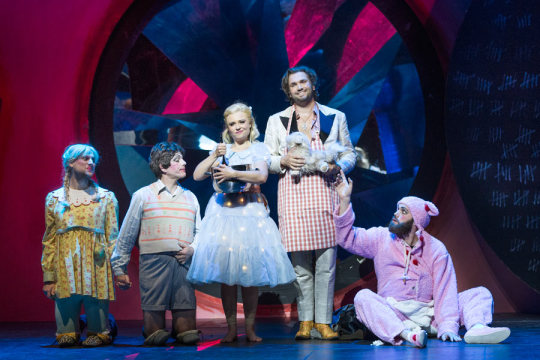
Likewise, Rigoletto can only imagine what happened between Gilda and the Duke at the Palace as rape (indicated by her disheveled costume).

There’s is no room for any kind of agency on Gilda’s part when it comes to her seduction. Rigoletto cannot bear the idea of his little innocent daughter-doll having her own ideas and desires. She is his prized possession and she was taken from him and used by another man. Her own feelings are of little importance to him as he swears vengeance on the Duke despite his daughter’s pleas for mercy.
GILDA’S RESISTANCE
While the story that plays out on the stage essentially is Rigoletto’s memory of events, Aniara Amos has included some subtle hints in the scenography and the direction that Gilda may not have been the meek, innocent and “pure” little doll of his memories.
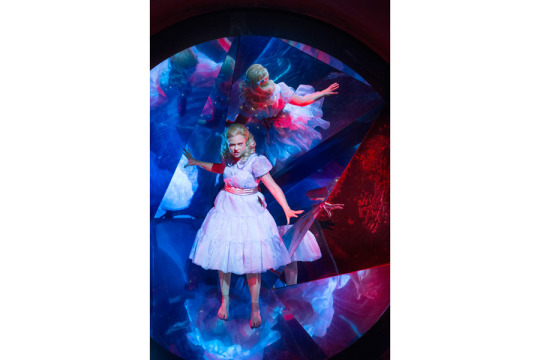
When Rigoletto opens the vault where he keeps Gilda locked away from the world, an important detail is revealed to the audience. The back of the vault door is filled with marks that counts the days of Gilda’s incarceration - thus hinting that she was NOT the compliant little girl that Rigoletto imagines her to have been.
Furthermore, when he turns his back on her, Gilda makes blatantly sexual gestures that contrast with the little girl image that Rigoletto has imposed upon her. Rigoletto doesn’t want to see Gilda as a sexual creature but the stage direction makes it clear that she isn’t the sexless little doll that he wants her to be.
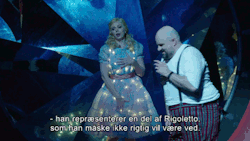

The gambit of letting the story be told after the fact, through Rigoletto’s memories, introduces a certain level of instability into the narrative. We, the audience, can’t discern what is memory and what is fiction that Rigoletto has created to shield himself from painful truths. It is an approach the opens up a narrative space for creating counter-histories if we begin to question as it is presented.
There are, as said, signs that Gilda was not content with being locked away from the world - and that she had sexual desires of her own. Little details that create cracks in the image of the pure, meek and submissive Angel in the House.
What if Gilda was not abducted? What if she ran away from an extremely controlling parent? Could it be that the sex she had with the Duke was consensual rather than forced as it appears in his memories?
These are all questions that address these subtle hints of a resistance on Gilda’s part and they are made possible by staging the story as a tale told retro-spectively.
MURDER MOST FOUL
I have always found Gilda’s death rather nonsensical since it is hard to imagine someone willingly sacrificing their life for a cheating douche that broke their heart. In the story of Rigoletto, Gilda’s death is not really about her character but about his pain, his tragedy.
However, Aniara Amos’ production creates the narrative space for the telling of a different story. In this story Gilda’s death is not the combination of self-sacrifice and accidental homicide but rather a murder most foul where a father murders his child. This is, of course, a speculative reading - but you have to bear in mind that in this particular production, the assassin Sparafucile is quite literally Rigoletto’s dark mirror - he represents the violent part of Rigoletto’s personality, which the costuming emphasizes.

Sparafucile wears a black version of Rigoletto’s jester’s hat - but in this production, it is ultimately Rigoletto that wields the dagger and it is him who delivers the killing blow. This is the only time that Aniara Amos’ production diverges from the original text where it is Sparafucile that kills the disguised Gilda.
Having Rigoletto delivering the killing blow himself is a very significant departure from the text - and this is narratively significant in a big way because it ties up all the subtle little hints of Gilda’s resistance with a much darker story. A story where a young woman’s resistance against parental control and her sexual awakening is punished by her father with murderous violence.
This is, in a sense, my counter-story to the traditional story of Rigoletto - but it is a counter-story made possible by subtle hints and details in the production as well as the narrative gambit of having the story told by a distraught man who has suffered a severe mental break-down. The audience is not in a position to discern between Rigoletto’s actual memories and the little fictions that he creates to soothe his guilty mind.

The final scene where Gilda sings about how glad she is to die for her beloved, as she slowly ascends to the heavens, may be just such a little fiction with which Rigoletto soothes his mind and tries to assuage his guilty conscience.
Controversy
This production caused quite a bit of controversy with the professional reviewers who either loved it or hated it. What I find interesting is the fact that the people who really hated Aniara Amos’ production mainly reacted against the aesthetics of the production. I can certainly understand that grotesque make-up, harsh lights, weird costumes and pornographic blow-up dolls might have been a bit too much for the delicate sensibilities of the petite bourgeoisie but I am always annoyed when they name these aspects an empty visuality that distracts from what they deem the main thing: the music.
Opera, however, is not just about the music - it is a story told through music, acting and stage-setting. You never really encounter critiques such as this with traditional productions of famous operas. In most of these cases, the stage-setting and costumes are just a pretty background for the music.
I need more from my theatrical experiences. I need a production that not only tells a story in an interesting manner - but also engages critically with it to make old stories relevant for a (post)modern audience. Staging Rigoletto in the same manner as it was done in the mid 19th century won’t do that. If opera becomes a museum of a specific musical culture, then it becomes less interesting - it should be a place where there’s room for debate.
Recently, a production of Carmen at the opera house of Florence, Italy, caused a big stir because the director chose to alter the ending of the story in order to make a statement about the abuse and mistreatment of women in our society. In this new production, Carmen kills her abusive lover in self-defense instead of being killed herself.
The producers said they had changed the denouement of the story in part to protest at the large number of Italian women who are killed each year by jealous husbands, boyfriends and lovers. So frequent are such murders that Italians have a name for the phenomenon – “femminicidio”, or femicide. Sociologists and campaigners say it is driven by men feeling threatened by the greater freedoms and enhanced economic independence that many Italian women now enjoy after decades of being seen as pliable possessions.
With horrific cases of domestic violence coming to light almost every month, the directors of the work said they were uncomfortable with the idea of audiences applauding the final scene, in which Carmen is stabbed to death and lies motionless on the stage.
“At a time when our society is having to confront the murder of women, how can we dare to applaud the killing of a woman?” said Cristiano Chiarot, the head of the opera house, the Teatro del Maggio Musicale Fiorentino. “I believe one can remain faithful to the spirit of the opera whilst taking certain liberties – as happened in classical times, when there were various versions of the most famous myths, without their original meaning being compromised,” he told La Repubblica newspaper.
Leo Muscato, the opera’s director, was initially resistant to the idea of changing the ending. “The death of Carmen is the engine that drives the opera, why reverse the situation?” he said. “Then I understood that what Chiarot was calling for was reasonable. The theme of death in the opera has a strong masculine element – the woman must sacrifice herself in order to save her freedom. It is a point of view that today makes no sense.” (x)
This is a rather long quote but I’m leaving it in because I have very mixed feelings about making such radical changes to the source material. It is one thing to make a radical interpretation of myths, legends and fairy tales that come from an oral tradition where details are altered with the re-telling. It is quite another thing to change the narrative denouement in the work of a named author.
A good director will be able to incorporate a social or political critique into a production - and that is exactly what Aniara Amos does with Rigoletto at the Royal Danish Opera. It is done subtly through the acting, lighting, costuming and stage-setting. It is an approach that demands an attentive audience, which mean that not everyone will “get it” - as evidenced by the pearl-clutching in a number of reviews.
(Thanks to the @thelawyerthatwaspromised for the GIFs)
8 notes
·
View notes
Text
What’s On in Copenhagen: April 2019
April in Copenhagen is a bit like a piñata: you don’t knouw what you get but it’s going to be a wild ride, that’s for sure. On a sunny day you can taste the beautiful Scandinavian summer on your lips. Then cloudy skies, wind, and rain take over and make you want to stay in bed, a cup of coffee within reach. Thankfully, Copenhagen’s cultural life is as diverse as its weather.
Here are the best things to do in Copenhagen this month:
Monday 1st April
ISTID at Depanneur Deli
Get a taste of Nørrebro in the city centre! Nitrogen ice cream concept ISTID launches their pop-up and will be serving ice cream and milkshakes from noon – 5pm during Depanneur deli hours for the rest of the coming summer 2019.
Tuesday 2nd April
Guided Tour with Copenhagen’s city architect Camilla van Deurs
Get out on the streets and let Copenhagen’s city architect Camilla van Deurs guide you through the best new architecture projects. The tour is organized by the Copenhagen Architecture Festival which takes place from 4th – 14th April. The event will be in English and tickets are available via the festival website.
Wednesday 3rd April
Danish Rainbow Awards
Every Year, the LGBTQ community celebrates individuals and organizations that have had a positive effect on the community. Join in Cirkusbygningen or watch the awards on TV 2 Zulu from 4 – 11 pm. Tickets are available here.
Thursday 4th – Sunday 7th April
Won Hundred and Maria Black Stock Sale
Get your hands on one (or several) of the beautiful pieces by Danish clothing brand Won Hundred and jewelry brand Maria Black without breaking the bank. During their stock sale in Nørrebrohallen they offer up to 80 % off their minimalist, high-quality designs.
Thursday 4th – Sunday 14th April
Copenhagen Architecture Festival
Scandinavia’s largest annual public event with a focus on architecture, design, and urban development brings 11 days of films, exhibitions, seminars, walks, and talks. Go on a guided photo tour to the city’s most interesting new architecture or watch a documentary about Moscow’s city development just after the October revolution; there is something for everyone. Find the full program for events in Copenhagen as well as in Aarhus, and Odense on the festival website. From Thursday 4th – Sunday 14th April.
Thursday 4th April
Sustainable Brand Index Awards
Who will be this year’s most sustainable brand in Denmark according to Danish consumers? Over 200 brands across a variety of industries in Denmark have been analyzed; the top ten are unveiled in this ceremony. There will be an introduction to the Sustainable Brand Index and the chance to mingle. Admission is free and the event takes place in Danish and English. Tickets are available via Eventbrite.
Aperitivo at Depanneur
Bring on the sweet summer vibes and join Depanneur’s Italian-inspired happy hour. Every Thursday there will be special deals on Aperol Spritz, Negroni, and natural wines as well as some snacks. From 4 – 8 pm.
Friday 5th April
Roastery Tour and Coffee Tasting at Coffee Collective
Coffee lovers alert! Every first Friday of the month, Coffee Collective’s roast master gives a tour of the popular company’s roastery, inviting guests to a cupping (fancy coffee language for tasting). The 150 DKK ticket price includes a bag of fresh roasted coffee to start off the weekend on the right note. No need for reservations, just show up.
Uniqlo Opening Day Celebrations
Minimalist, affordable Japanese basics brand UNIQLO celebrates the opening of the brand’s first store in Denmark with special deals, coffee, tea from Sing Tehus, and cake from Andersen’s Danish Bakery. The doors open at 9:30 am, accompanied by Japanese Taiko drummers.
Saturday 6th April
Knowledge Sessions by Relevance
Learn about music production, the famous Article 13, and meet electronic music-lovers in workshops and talks organized by Relevance Festival. Then stay for the party and dance until the early hours. Admission to the Knowledge Sessions events is free and tickets for the party are available via Billetto.
Open rehearsal of the Royal Danish Ballet
Look behind the scenes of the Royal Danish Ballet at this open rehearsal of Afterrite. Admission is free but follows the first come, first served principle. So come early to secure yourself a spot. From 11:30 am – 1 pm.
Sunday 7th April
The Young and the Damned by Luis Buñuel at Louisiana Museum of Modern Art
The film “Los Olvidados,” about a group of destitute children in Mexico City, is one of the most well known works of director Luis Buñuel. As part of the Copenhagen Architecture Festival, the screening will be accompanied by an introduction by architect Tatiana Bilbao as well as a talk with Pernille Maria Bärnheim. From 11:30 am – 1:45 pm.
Monday 8th April
Snack and Blues Opening at Copenhagen Zoo
Snack and Blues is launching a venue within the lovely Copenhagen Zoo. From now on, you can enjoy your favorite burger in the sun while visiting a variety of wildlife.
CHART Architecture Kick-off 2019: Exploring Materiality at Apollo Kantine
CHART Architecture is an annual pavilion competition for students, young architects, designers and artists. The five winning teams will build their designs in Kunsthal Charlottenborg’s courtyard during the international CHART art fair from 30th August – 1st September 2019. The competition kicks off with a lecture by artist Lea Porsager and senior curator Pippo Ciorra about this year’s theme: materiality. From 5 – 7 pm.
Tuesday 9th April
Open mic for Red Barnet Ungdom
Laugh for a good cause! Every Tuesday, Huset-KBH hosts a stand up session with new and experienced comedians to support Red Barnet Ungdom. Doors to Musikcaféen open at 7:30 pm and admission is 25 DKK.
Friday 12th – Wednesday 17th April
Future Food Today at SPACE10
Research and Design Lab SPACE10 invites you to celebrate its first cookbook. Check out the exhibition and make sure to sample a few goodies from the newly opened Test Kitchen. The cook book Future Food Today is a collection of delicious, sustainable, and future-proof recipes and also includes guides to producing and sourcing food locally and sustainably with the help of alternative ingredients and technology. You can reserve your copy via the website or buy one at the gallery. From 10 am – 5 pm every day, closed on Sunday. Admission is free.
Friday 12th April
Friday Bar: Big Talk at Think
Tired of small talk? Dive into the big topics
Vernissage “Drawing Attention” at De Frie Udstilling
“Drawing Attention” puts the spotlight on the art of drawing. Swing by the vernissage between 5 – 8 pm and be among the first people to see the exhibition which runs from 13th April – 22nd May.
Afgang 2019 – Exhibition by graduates from the Royal Academy of Fine Arts
Join the vernissage of the degree show of the graduates of The Art Academy. From video and painting to sculpture and performance art; the styles and modes of expression vary, giving an insight into the potential future of contemporary Danish art. The exhibition runs from 13th April – 19th May.
Monday 15th – Saturday 20th April
Copenhagen International Improv Festival
Laugh until your face hurts when performers from all over Europe and North America come to Copenhagen. Improv comedy is created on the spot, making it an especially entertaining and impressive experience. There will be more than 60 shows on two stages as well as workshops and dinners. Find your ticket on the festival website.
Monday 15th April
Mogli at Lille Vega
Mogli’s dreamy sound is inspired by her travels across North America in an old, renovated schoolbus. Let her take you on a journey to open plains and turquoise lakes. Doors open at 8 pm and tickets are 200 DKK.
youtube
Tuesday 16th April
Women in Data Science
Take this opportunity to hear about the latest data science research and applications. The event is part of the global Women in Data Science initiative, organized by Stanford University. The conference features exclusively female speakers and mentors from industry and academia who are doing outstanding work in Data Science. Tickets cost 100 DKK and include lunch and coffee. From 9 am – 6 pm.
Wednesday 17th – Saturday 20th April
Den sidste nadver at Xenon
Based on Paolo Genovese’s film “Perfetti Sconosciuti,” this play follows a group of friends as they turn a dinner party into a game. Every call, text, email or instagram notification that is received during the dinner has to be shared with everyone at the table. How much do we really want to know about our friends and partner? The new group PULS explores honesty, sexuality, and egoism in the digital age. Doors open at 7 pm.
Wednesday 17th April
Welcome to the World Wide Web – Language at SPACE10
The language of the internet is transforming. Memes, emoji, voice recordings and video-stories change our conversations and whose voices get amplified. In the World Wide Web series, Research and Design Lab SPACE10 explores how digital technologies empower people across the world. Language is the third and last event of that series. Curious? Get your ticket via Eventbrite. From 5 – 8 pm.
Friday 19th – Sunday 21st April
CPH Art Space
Get your dose of art on the easter weekend and browse the works of over 60 artists at Docken. The three day ticket costs 40 DKK on pre-sale.
Friday 19th
Andy Warhol presents: “Trash” and “Frankenstein” at Husets Biograf
Two of the most compelling underground films of the early 70s are screened at Husets Biograf. Both were created by Warhol’s in-house film director Paul Morrissey and star his most famous acting discovery, Joe Dallesandro. Doors open at 6 pm and the first film, “Trash,” starts at 7 pm. Admission is 60 DKK.
Saturday 20th April
Okay Kaya at Ideal Bar
Kaya Wilkins started publishing music on SoundCloud in 2014 while working as a model for brands such as Calvin Klein. Last year, she dropped her debut album Both. When she sings about mental health, alcohol abuse, and sex, her warm voice creates a feeling of intense intimacy. Doors to Ideal Bar open at 7 pm and tickets are 145 DKK.
youtube
Sunday 21st April
Danish on a Sunday: Wildwitch at Cinemateket
A black cat, a girl and a pinch of magic, the recipe for a cosy Sunday afternoon with the whole family. When 12-year-old Clara is scratched by a mysterious black cat, she discovers that she can communicate with the cat and that she belongs to a family of wild witches. Not only does she have a strong connection to nature and animals, her blood can also set free an ancient and evil witch. Watch Kaspar Munk’s powerful adventure, in Danish with English subtitles at 2:15 pm.
Monday 22nd April
Nanjing talk and screening of Spring Fever at Cinemateket
First, Professor and China expert Jørgen Delman talks about contemporary China. After that, there will be a screening of the award-winning Chinese-French movie “Spring Fever“ by Lou Ye. The film is in defiance of a five-year ban on filmmaking imposed by the Chinese government. It is a poetic depiction of a love pentagon that blurs the lines of heterosexual and homosexual relationships. The talk is in Danish and the movie is screened with English subtitles. The event starts at 4:15 pm. If you can’t make this one, don’t worry: there will be another screening on 30th April at 9:15 pm.
Tuesday 23rd April
Science & Cocktails – Panel Debate: The State of the Climate
Science & Cocktails presents a debate on the current state of the climate. Speakers are Katherine Richardson, who studies the impact of climate change in the oceans, Jørgen Olesen who focuses on the effect of climate on agriculture and food systems, former head of climate research at the Danish Meteorological Institute, Jens Hesselbjerg, and
Kirsten Halsnæs who has taken a leading role as an economist in the IPCC panel. Admission is free and the doors open at 7 pm.
Thursday 25th April
The Future of Tech & Politics: Imagining 2050 at Talent Garden Rainmaking
Fast forward to the year 2050 with this thought experiment in which speakers and participants are challenged to imagine a society 30 years from now. Free tickets are available via the Facebook event and via Eventbrite. From 5:30 – 8 pm.
Friday 26th – Sunday 28th April
Street Food Festival Copenhagen
Get some fresh spring air and treat yourself to yummy street food. Hans Tavsens Park turns into a culinary oasis with some of Denmark’s most interesting food concepts cooking up delicacies for you to try.
48Timer Festival
Get a taste of Nørrebro’s cultural life and join the several workshops, concerts, exhibitions and street parties taking place in the neighborhood. Find the program on the festival website.
Friday 26th April
&Tradition x 506 Friday bar
The courtyard café of Danish design company &Tradition celebrates the arrival of spring together with food lab 506. Be the first to get a taste of the new spring menu developed by 506, and check out the newly launched to-go picnic basket – perfect for lazy days in The King’s Garden just across the street. The celebration starts at 4 pm at Kronprinsessegade 4.
Saturday 27th – Sunday 28th April
Sakura Festival
Celebrate the beautiful cherry blossom and Japanese culture at the Sakura Festival. There’s nothing quite like those fluffy pink blooms, and they’re around for such a short time. The program will be available on the festival website.
Saturday 27th April
Plantemarkedet i Absalon
Welcome spring and flex your green thumb when Absalon turns into a plant paradise. There will be plants of all kinds as well as interior and ceramics for sale. Admission is free and doors are open from 10 am – 4 pm.
Sunday 28th April
Loppemarked og musik 48Timer
Go on treasure hunt on this indoor flea market in Nørrebrohallen. Admission is free and the market runs from 10 am – 3 pm. If you’d rather free up some space at home, you can rent a stall for 275 DKK via Billetto.
Tuesday 30th April
Elias Boussnina at Lille Vega
Having started his career under the rap alias Young Coke while studying at Copenhagen Business School, Elias Boussnina is back under his own name and with a new sound. On his debut EP Shameboy from February, he pairs R&B/pop with electronic beats and builds on the success of last year’s single “05:30.” See him perform at Lille Vega. Doors open at 7 pm and tickets are 145 DKK.
youtube
Ongoing in April
Wine O’Clock at MULGEO Blini Bar
Every Friday from 4 – 6 pm, enjoy a complimentary glass of wine with your blini purchase. MULGEO is a blini bar having a long-term pop-up at Torvehallerne. Their fluffy blinis are topped with seasonal, local ingredients; a perfect bite! You can buy the blinis individually for a snack, or three for a meal. On Mondays from 2 – 5, they’re sharing information about oysters, including tasters!
The Thirst at Galleri Nikolai Wallner
In Marie Lund’s exhibition “The Thirst, six copper sculptures are placed in the gallery. Their shape is determined by a single form. Shown in full, in part, flipped, inverted, the sculptures appear like the grammatical conjugation of a single word unfolding or a body moving through different poses. The exhibition runs until 27th April.
Sonja Ferlov Mancoba at Statens Museum for Kunst
SMK is presenting the largest exhibition ever staged of the sculptures, paintings, collage and
drawings created by Danish-French artist Sonja Ferlov Mancoba. Inter-human connectedness and
a global outlook are core themes in her art as well as her life. The exhibition runs from 9th
February until 5th May.
Kids Easter Workshop at SMK
Get inspired by the current exhibition on sculptor Sonja Ferlov Mancoba and make your own plaster sculptures and easter eggs with a twist. The workshop is free for everyone, however adults need a valid ticket for the museum. From 11 am – 4 pm on 13th – 22nd April (except of 15th April).
Afgang 2019 – Exhibition by graduates from the Royal Academy of Fine Arts
The exhibition celebrates and presents new works created by the graduates of the academy. From video and painting to sculpture and performance art, the modes of expression vary and give an insight into the future of contemporary Danish art. The exhibition runs from 13th April – 19th May.
Sart og sjældent set (Delicate and rarely seen) at Glyptoteket
See selected works from Glyptoteket’s stock rooms. Experience fine drawings, fragile plaster, and easily degradable materials such as cardboard, gravel, and rubber that are rarely made available to the public due to their delicacy. The exhibition focuses on materiality and sensibility and features works of artists such as Astrid Noack, Alberto Giacometti, Joan Mirò, and Friedensreich Hundertwasser. Until 28th April.
Bauhaus – It’s All Design at Designmuseum Danmark
Designmuseum Danmark takes part in the international celebration of 100 years of Bauhaus with the research-based exhibition “Bauhaus – #itsalldesign.” Developed by Vitra Designmuseum and
Bundeskunsthalle Bonn, the exhibition explores all aspects of this design school’s activities and how contemporary design passes and builds on the heritage of Bauhaus. From 14th March – 1st December.
The Vitality of Colour at Kunstforeningen GL Strand
Having been declared a “degenerate” artist by the National Socialist regime, Hans Purrmann was one of Germany’s most significant modernist artists. Kunstforeningen GL Strand is showing a retrospective of his works along with a selection of the artists who he collaborated with or was inspired by. These include Max Liebermann, Henri Matisse, and Mathilde Vollmoeller as well as writer Hermann Hesse. From 27th April – 15th September.
Interplantery Cabinet at Gallery Christoffer Egelund
Jonas Phil’s artworks are painted directly on the surfaces of the original model planets from The Tycho Brahe Planetarium in Copenhagen, which he purchased at an auction. Experience his creative expression situated somewhere between painting and sculpture as well as paintings on canvas that imagine other worlds. The exhibition opening event is on 12th April from 4 – 7 pm, and runs until 11th May.
If you’re a business or organisation that would like us to add your event to next month’s calendar, please contact us at hello [@] scandinaviastandard [dot] com. Thank you!
Stay Up to Date with our Newsletter
Get new articles, interesting links and upcoming events delivered to your inbox every month. No spam. Unsubscribe whenever you want.
#mc_embed_signup{background:#fff; clear:left; font:14px Helvetica,Arial,sans-serif; width:624px;} /* Add your own MailChimp form style overrides in your site stylesheet or in this style block. We recommend moving this block and the preceding CSS link to the HEAD of your HTML file. */
Email Address
First Name
Last Name
What’s On in Copenhagen: April 2019 published first on https://medium.com/@OCEANDREAMCHARTERS
0 notes
Text
New upload of ballet essay
Ballet was a style of dance that originated in Italy during the renaissance of the 15th century. The Italian renaissance started in the 1330s and finished in the 1550s. the Italian renaissance generally covers the periods from the beginning of the fourteenth century to the end of the sixteenth century. the renaissance marked a great cultural change throughout the whole of Europe and is viewed as a bridge between the medieval and modern ages. The renaissance started in Italy because there were small break in the Christendom atmosphere and environment that had previous shaped Italy which led to freedom and independence. the newfound freedom and independence along with the presence of the ruins of Roman civilisation led to the renaissance. Ballet spread from Italy to France this happened because of Catherine de Medici, she was born in the early fourteenth century into a very rich family. Ballet had a central theme that a story, sets, costumes, music and dialogue. after its success De Medici had Beaujoyoux write down the libretto and music. She had artists draw pictures of the events and set them to the courts of Europe. the world was impressed that they tried to emulate similar ballets. They also replaced their ballet masters with those from France this is how the language of ballet became French. The first ever formal ballet was called the Ballet Comique De La Reine this was staged October 15th 1581 to the court of Catherine de Medici it was created for the wedding celebration of queen Louisa’s sister. The usual people to watch ballet performances were the rich and wealthy families because tickets were very expensive and the poor struggled to buy them because of being lower class so the rich and famous were the only ones who watched the performance. The Academie royal de musique was then named the paris opera its the primary opera company in France. it was founded in 1669 by Louis XIV. Louis XIV was a monarch of the house of bourbon who ruled as king in France from 1643 until his death. each year the opera presented about 380 performances including opera performances and ballet to the total audience of about 800,000. 1661- founding of the academie royal de danse by Louis XIV with the purpose of training dancers and formalising choreographic art. 1669- founding of the academie de musique, the institute brought together a group of singers, the first professional orchestra in France 1681- the ballet of the opera opened it doors to women dancers for the first time. Ballet evolved from social court dancers in Italy and France, rich and wealthy people would try to outdo each other by having the most elaborate courts. There social dancers soon evolved into a choreographic form, ballet de court dancers moved to the stage brining a change In choreography as the dancers were seen from only one direction, this was performed in the 15th and 16th century. In 1725 Pierre Rameau created the codification of these five foot positions to choreographer Pierre Beauchamp, the evolution of ballet technique dated back to Louis XVI. The first ballet de cour to be performed was the “cirlcle ou le balet comique de la royne” performed in 1581 at the courts of Catherine de Medici from then on ballet cours had been performed at festivals, wedding, christenings. In the 18th century ballet advanced technically and also ballet became a very serious and dramatic form of art. Also ballet divided into three formal techniques, “serieux, Demi caractèr and comiqúe” also in the 18th century ballerinas began to tell stories of lives of ordinary people. Dancers started to follow fashion they thought Grecian dresses emphasised the body, they wore flat slippers which allowed greater flexibility in the feet. Men wore jackets and fitted breaches, these costumes meant men and women could dance freely together, in the 19th century ballet developed when Marius petipa was ballet master in St. Petersburg, also 2 of the most famous ballets of all time where choreographed “nutcracker” and “swan lake” The American revolution happened between 1765 and 1783 this happened because of a political event. The French Revolution was an event which happened in 1789 until 1799 and this happened because a far-reaching social and political upheaval in France. I’m the early 18th century not many people went to church, most people went on a Sunday however there was lack of energy and enjoyment. Augustus Bourneville was a danish ballet master who had trained with his father for many years as well as training with his father he studied under the Italian choreographer “Vincenzo galeatti” as a famous choreographer he created a number of ballets with settings that ranged from Denmark to Italy, and from Russia to South America. His style was very unique and he made it his own, his work didn’t become known until after the Second World War. After this he became a dancer at the royal ballet. Enricco cecchetti- enricco was an Italian ballet master, and he was the founder of the Cecchetti method- this is a ballet technique and rigorous training made by him, it is specifically concerned with Hiltons law of atonomy. He was praised for his ability and strength in performances and because of this in 1888 he always accepted as the greatest ballet virtuoso in the world. In 1902 he left the imperial ballet to accept the directorship of the imperial ballet school in Poland. Marius ivanovoch Petipa- was a French and Russian ballet master, in 1825 he started ballet lessons and made it in one of his fathers productions 2 years later, he was most known for the ballets he created, “the sleeping beauty” and “nutcracker” in his early years he started travelling Europe with his father (ballet master) and his mother (actress). He is knows to be the most influential ballet master in the history of ballet Carlos is an Italian ballet teacher and write on the technique history and theory of dance, he was the first to codify and publish an analysis of the classical ballet technique. He was born November 4th 1803 in the kingdom of Naples in Italy and he unfortunately died January 15th 1878. Blasis danced briefly at the “Paris opera” he also performed and choreographed at the “kings theatre” in London and then he was appointed director at La Scala. I researched some of his most famous pieces of his work and I came across, The Code Of Terpsichore made in London this was published in 1828,An Elementary Treatise upon the theory of practice of art and made in Million this was published in 1820, Notes upon dancing this was made in London and published in 1847, National dancers this was made in Moscow and published in 1864 and Intalettuale e moral made in Millan and published in 1857. The romantic period began in the early nineteenth century and reflected the romantic ideas of art and literature of that time. The romantic era was a time of fantasy, supernaturalist and exoticism. The stories of the time dealt with issues of good vs evil, woman became the superstars of ballet with pointe work which gave the illusion of floating. Marie Taglioni was a ballet dancer from the romantic era, she’s from Paris and she was born 23rd of April 1804 and died 24th of April 1884. Marie was the first woman to dance on pointes, she created the style of floating leaps, balance and posses. In the nineteenth century she was important for perfecting technique with slippers in her long white romantic tutu and pointes she became the new image of the romantic era. The common costume worm for romantic ballet was close fitting bodices, floral crowns, corsages, white floating tutus, and pearls on everything. Through research I have found various ballets of this era including, La Somnambule, La Sylphide, La Gipsy, Giselle I really like gisselle because I really think the romantic tutus had an effect of the theme of romance, I also liked the effect on the man lifting the woman it shown the theme love, I also thought the elegance of the woman on pointe shoes shown floating and this shown romance I didn’t really like how the man hardly did anything he only lifted and followed the woman around the stage I also disliked the lack of emotion and the speed of the music because romance should show happiness but the accompaniment shown sadness. Britain took ballet to a wider audience by Ninettes company during the Second World War, Ninette was an English ballet dancer, choreographer and company director in the 20th century. In her early years she trained at the “Lila field academy” she created the company Sadler wells in the 20th century, then later on to be called “the royal ballet” in his time the school was open she employed Robert Helpmann and Fredrick Ashton. Robert Helpmann was an Australian dancer From the 20th century, he became an International ballet star and choreographer as well as an actor and director. Robert first appeared on the stage in 1923 he joined Anna Pavlova’s company and toured New Zealand and Australia. In 1933 he went to study in London and then later joined “Sadler wells” he danced opposite Alicia Markova, he became the regular partner and they were becoming more famous during the Second World War. As well as being a ballet dancer he was a choreographer, he liked to create ballets that were very theatrical and often contained elements of violence. Fredrick Ashton Fredrick was a British ballet dancer and choreographer in the 20th century he was also a director in opera and film. He stared dancing late due to 3 years in boarding school, he lacked in technique and strength but he had private lessons every week with Leonid Massine and his technique and strength improve massively. He was astonished by Anna Pavalos performance and he has wanted to dance ever since, after he finished at Rambert Company he then became the principal choreographer of Sadler wells in 1935. Then in 1952 he was made associate director of the royal ballet and continued to choreograph. Marie was a Polish-born dance in the 19th and 20th century, she exerted great influence on British ballet. Her company “the rambert company” opened in 1914 it’s one of Britains oldest dance companies. The company was made during the outbreak of the First World War when Marie arrived in London, when she arrived in London she supported herself by teaching dance. Her dance company first performed in 1926 performing a ballet. Ballet flourished in denmark in the late 18th century (1771) when the “royal danish ballet school” was created in 1775 the Italian ballet dancer Vincenzo Galeotti attracted local dancers and the national identity began to flourish. Vincenzo Galeotti was an Italian dancer, choreographer and teacher in the 18th and 19th century, he was the director of “the royal danish ballet school” and he studied in Italy with Gaspero Anglioni, he choreographs opera ballets and divertissements. 1769-1771 he danced at the “Londons king theatre” after his career of dancing he decided to dance until the age of 77 and in his time he was responsible for creating a repertoire of 30 ballets. Russia- ballet flourished in Russia in the romantic era 1830-1850 there was many people who helped flourish ballet all over the world for example, Vaslav Nijnisky - he was a Russian choreographer and ballet master in the 19th and 20th century, he became a soloist at “marlinsky theatre” in 1909 he joined “serge diaghileves” and choreographed “la spectra de la rose” also Rudolf Nureyev- soviet ballet dancer and choreographer in the 20th century, in 1989 he returned to Russia and danced la Sylphide and in 1990 he performed in the musical “the king and I” Another person who helped was Marius Petipa she was a French and Russian ballet dancer and choreographer. Research more in to Petipa and find out about his work and what’s he most famous for, and the ballets he recreated. Marius Petipa produced over 60 ballets and directed many of the greatest artists in Russian ballets and developed ballets that retain an important position in Russian dance repertoire His work consists of - The Nutcracker - The Sleeping Beauty - Swanlake - And many more… 3. Micheal Fokine had great influence of taking ballet from Paris, to Sweden and the USA. How did he make ballets different? How did he believe ballets should be performed and what did he think about costumes? Micheal Fokine made ballets different by adding elements of religious style dancing such as Ancient, Greek and roman. The vocabulary of classical ballet has been enormously extended since Fokines day. Subsequent audiences feel that his choreography is dates. He believed ballets of his time used costuming that did not reflect the themes conveyed in the ballets, therefore he studied Greek and Egyptian art and he used outdated costumes. 4. George Balanchine is a huge influence into ballet in the USA, find out how he adapted ballet in to a more modern way and what classical pieces did he create? George Balanchine was a choreographer, farther of the American ballet and co- founder of “ the New York City ballet” he choreographed many musical comedies for broadway and Hollywood, he made more than 500 pieces of performances and they have been performed by every ballet companies in the world. He created ballets and he believed the performance should outshine an individual. Modern ballet is an element of classical ballet and modern dance incorporated into one. During the 1900s European dancers started to rebel against the classical ballet rules, they changed the structure, techniques, costumes and shoes of ballet, this then made the dancers feel more relaxed, in the early 20th century modern ballet was a dance style that focuses on a dancers own interpretation. Modern ballet and classical ballet are very different, modern dancers dance in hate feel and revealing costumes, modern dance. It all comes around from Martha graham, classical ballerinas dance in ballet shoes and leotards, modern dancers have their own interpretations in dance technique and classical ballet dancers follow a technique and certain rules. Modern ballerinas use the emotions and moods to design their own movement and routines whereas classical ballet dancers strive to be light in their feet, a classical ballerina is upright and they have an erect body. Martha graham was a big influence on modern dance she created a style/technique familiar to classical ballet, she focused heavily on human movement and contract and release. Contemporary ballet is a style that incorporates many element such as modern, classical ballet and contemporary. Ballet dancers are expected to have great technique they have to be versatile, they must maintain an excellent fitness and work on each performance with emotion. Bussell believes that modern dance should include “surprising things” such as “gymnastic elements” and “roller skates” Dancers have to be more diverse, they have to try every genre Darcy says “try every genre you have to be much more diverse now as a dancer” William Fersythe is an American dancer and choreographer born 30th December 1949. His body of which, which displayed both abstraction and forceful theatricality, deconstructs the classical ballet repitore by adding spoken word music and art installations. 1978 he began to move beyond traditional ballet and present his own dynamic and unconventional vision. Ager watching a clip of his repertoire Artifact, I noticed in the choreography the acompliment has talking over the top of classical music, the choreography contains mirroring and unison and contains element of jazz and contemporary. The movement is fast and isolated and the dancers are in a plain costume running off and on stage. I also noticed that in the performance Sleeping Beauty the costumes are glamorous and sparkly, the music is very classical and the dancers are dancing together including lifts and body. The Cecchetti method is a ballet training math of devised by the ballet master Enrico Cecchetti, he was an Italian ballet dancer and founder of the Cecchetti method. Enrico developed a good technique and was noted for his pirouettes, this method is strict and it enforced routines for each day carefully considering the laws of anatomy the skills learnt from this are flexibility in both legs, focus of quick feet, crisp lines and seem less transitions. August was a danish dancer and choreographer in the 19th century he directed the royal danish ballet for 50 years and established the danish style on bravuva and expressive mime. Augusts methods of training include the traditional French method, his technique features very basic use of arms, enpaulments, pirouettes with low developpe in second and preparatory posting. Www.danceinfo.com Www.dance.about.com Www.dancemagazine.com Www.williamforsythe.de Www.abcballetschool.org Www.britancca.com Vam.ac.uk Www.theballegblog.com Www.oxfordrefrence.com Www.factsanddetails.com Wwwbritannca.com Www.nureyev.org/rudolf-hureyev Www.roh.org.uk Www.woodlandscivicballet.com Www.nycballet.com Sites.google.com Californiaballet.wordpress.com Https://www.britancca.com Www.newworldencyclopedia.org Www.dance.enthuast.com Www.tutuetoile.com Www.roh.org.uk Www.nytimes.com Www.britancca.com Www.fredrickashton.org.uk Www.brb.org.uk Www.rambert.org.uk
0 notes
Text
Things to do in Montréal March 17 to 23
Even in the midst of a snow storm, the idea of spring is on the minds of Montrealers by late March – one of the sure signs of the season is the city’s huge St. Patrick’s Day parade, joined this week by sugar shack season, a Pink Floyd opera, the vivid colours of Chagall, butterflies at the Botanical Garden, and plenty more.
St. Patrick’s Day party
Montréal may be one of the biggest French speaking cities in the world, but its varied history wouldn’t be quite as colourful without its long-standingn Irish contingent. That’s why Montréal boasts the longest consecutive running St. Patrick’s Day parade in the world – see what it’s all about on March 19 as the parade dances and drums for all ages along Sainte-Catherine Street downtown. Add to the annual tradition by raising a glass at the city’s best Irish pubs – our guide to 10 things you didn’t know about the St. Patrick’s Day celebrations in Montréal makes for great bar fodder.
Une publication partagée par #CINQCENTQUATORZE ® (@jfsavaria) le 16 Mars 2017 à 7h52 PDT
Spring anticipation
Snowstorms rival sunny days in March, so if you’re here on Spring Break, keep your plans flexible: our guide to restaurants, bars and parties for spring break in Montréal has plenty of ideas for letting loose, while our guide to things to do for families during spring break engages kids and adults alike in fun activities. Indoors: take a walk through the underground city to see Art Souterrain‘s miles of art installations; frolic among the butterflies indoors at the Botanical Garden’s wonderful Butterflies Go Free event, part of the Montréal Space for Life‘s many activities; or see the characters of classic comic Astérix step off the page at Grévin Montréal wax museum’s exhibition. And on the ice, the Montréal Canadiens take on the Senators on March 19, Red Wings on March 21 and the Hurricanes on March 23, at the Bell Centre.
Food and drink
With spring on the horizon, it’s officially sugaring off season in Québec – that means the maple syrup’s flowing and the tables are stacked with tortiere, sugar pie, sausages and so much more – indulge in a Québecois sugar shack meal in the country or the city. Learn – and eat – more in a free Sugar Shack Workshop with Urban Bonfire on March 20. Or dig into lunch at the Casino de Montréal’s tropical-themed Copacabanashak Buffet. Explore the menus of new Montréal restaurants to find original dishes and welcoming ambience. Warm up with a cup of tea at Montréal’s tea houses, a big bowl of pho or Japanese authentic ramen, a signature winter cocktail at one of Montréal’s Hidden Bars, or a relaxed evening next to Montréal’s coziest fireplaces. Follow it all up with a trip to the candy shop. And for true food enthusiasts, hear esteemed Swedish chef Magnus Nilsson in conversation on the topic of Nordic cuisines, at the Phi Centre on March 20.
youtube
On stage
Montréal’s 375th anniversary celebrations shines the spotlight on composer Julien Bilodeau’s Another Brick in the Wall, an operatic version of Roger Waters’ The Wall, making its world premier at Place des Arts March 11-27. Montréal’s winter-spring dance program includes the not-to-be-missed Akram Khan Company’s Until the Lions, March 17-25 on an amazing circular stage set by Tim Yip at La Tohu and Les Grands Ballets‘ contemporary dance presentation of Ohad Naharin’s Minus One, March 23 to April 1. In theatre: follow the lives of a Korean-Canadian family in Ins Choi’s hit comedy Kim’s Convenience at Segal Centre to March 19; Centaur Theatre presents thoughtful, humorous family drama You Will Remember Me; Black Theatre Workshop and Tableau D’Hôte co-present Angélique, based on Marie-Joseph Angélique, a slave executed for allegedly set fire to Montréal in 1734, at the Segal Centre to April 2; and Battlefield brings ancient text The Mahabharata to the stage, directed by Peter Brook, at Place des Arts. For kids, there’s the excellent children’s theatre of Geordie Theatre Fest, March 21-26. And for adults, local and international queens of burlesque make Monde Osé’s Royal Burlesque Ball an extravagant, sexy, sparkling affair on Saturday, March 18 at the Rialto Theatre.
youtube
On screen
Step into the Virtual Reality Garden installation at the Phi Centre, where you can also see selected independent films from the Venice International Film Festival starting March 21 with Heartstone. The Cinémathèque québécoise‘s free installation Détectives de la Pataphysique showcases the awe-inspiring films of Clyde Henry Productions’ Chris Lavis and Maciek Szczerbowski (known for animated short Madame Tutli-Putli among other eclectic work.) Immerse yourself in high-tech films Inertia and Morphogenesis in the Satosphere surround-sound dome. The wonderful International Festival of Films on Art screens features and shorts focused on art, music, dance, film and more, March 23 to April 2. And see if you can name the city sights in these movies filmed in Montréal.
Une publication partagée par @evablue le 14 Mars 2017 à 9h30 PDT
Museums and galleries
The beautiful world of CHAGALL: COLOUR AND MUSIC awaits at the Montreal Museum of Fine Arts, featuring 340 pieces by the Russian-French artist accompanied by music. The Musée d’art contemporain shows moving work by foremost Mexican artist Teresa Margolles, as well as Québec artist Emanuel Licha’s Now Have a Look at This Machine documentary installation. Galerie de l’UQAM presents noted Scottish artist Graham Fagen‘s video and music-based installation The Slave’s Lament. Part of the 375th programming, kanien’kehá:ka (Mohawk) artist Skawennati’s solo exhibition Tomorrow People explores time and identity in analog and digital forms at Oboro. DHC-ART‘s excellent solo show of Belgian artist Wim Delvoye closes on March 19. Never Apart’s winter exhibition celebrates Black heritage, Indigenous women and more. Take a look back in time at the McCord Museum‘s Fashioning Expo 67, featuring over 60 outfits and products made for the Expo 67 world’s fair by Quebec designers. And find art and architecture in the city’s most stunning churches and other sacred sites.
youtube
Live music
Friday night’s a big one with British rockers Bring Me The Horizon with Underøath and Beartooth at Uniprix Stadium, father-and-son Canadian folk-rock stars Bill and Joel Plaskett at L’Astral, indie-rockers The Zolas and Louise Burns at La Sala Rossa and Ancient Future presenting a live set by Jacques with opener Xarah Dion at Theatre Fairmount. Sing along on Saturday with The Lumineers at the Bell Centre or Matthew Good and Craig Stickland at Théâtre Corona, it’s a night of wacky mischief at the ShazamFest Awards��music-and-burlesque show at Matahari Loft, and Dutch producer Oliver Heldens brings the house down at New City Gas. Scottish heavy metal band Alestorm and Aether Realm get heavy at Théâtre Corona on Monday night. On Tuesday, it’s a good time all around with L.A.’s Allah-Las at Théâtre Rialto. On Wednesday, pop-punk fans come out in full force for Green Day and Against Me! at the Bell Centre, while Danish electronic producer and musician Trentemøller plays Théâtre Corona and Great Lake Swimmers entertain at La Sala Rossa. Kent Nagano conducts the Orchestre symphonique de Montréal in a tribute to Olivier Messiaen, at Place des Arts March 21-22. And Jakarta Records artist Norwegian MC Ivan Ave grooves at the Phi Centre on March 23.
Up next:10 things you didn’t know about St. Patrick’s celebrations in Montréal
The post Things to do in Montréal March 17 to 23 appeared first on Tourisme Montréal Blog.
http://ift.tt/2m5ZhBa
0 notes
Text
Classical ballet essay
1.find out what century ballet began and where it originated ballet was a style of dance that originated in Italy during the renaissance of the 15th century. 2. what is the renaissance and what century was it to and from? The Italian renaissance started in the 1330s and finished in the 1550s. the Italian renaissance generally covers the periods from the beginning of the fourteenth century to the end of the sixteenth century. the renaissance marked a great cultural change throughout the whole of Europe and is viewed as a bridge between the medieval and modern ages. The renaissance started in Italy because there were small break in the Christendom atmosphere and environment that had previous shaped Italy which led to freedom and independence. the newfound freedom and independence along with the presence of the ruins of Roman civilisation led to the renaissance. 3. find out what country ballet spread to and who helped with this? ballet spread from Italy to France this happened because of Catherine de Medici, she was born in the early fourteenth century into a very rich family. It had a central theme that a story, sets, costumes, music and dialogue. after its success Catherine had Beaujoyoux write down the libretto and music. she has artists draw pictures of the events and set them to the courts of Europe. the world was impressed that they tried to emulate similar ballets. They also replaced their ballet masters with those from France this is how the language of ballet became French 4. when was the first ever formal court ballet and what was it called? it was called the Ballet Comique De La Reine this was staged October 15th 1581 to the court of Catherine de Medici it was created for the wedding celebration of queen Louisa’s sister. 5. what type of audience where ballets performed too? the usual people to watch ballet performances were the rich and wealthy familys because tickets were very expensive and the poor struggled to buy them because of being lower class so the rich and famous were the only ones who watched the performance. 6. research in to Academie Royale de Musique what century was it founded? who was the founder? why was it significant? the Academie royal de musique was then named the paris opera its the primary opera company in France. it was founded in 1669 by Louis XIV. Louis XIV was a monarch of the house of bourbon who ruled as king in France from 1643 until his death. each year the opera presented about 380 performances including opera performances and ballet to the total audience of about 800,000. 1661- founding of the academie royal de danse by Louis XIV with the purpose of training dancers and formalising choreographic art. 1669- founding of the academie de musique, the institute brought together a group of singers, the first professional orchestra in France 1681- the ballet of the opera opened it doors to women dancers for the first time. 7. research into Court ballet, what is court ballet? what century was it performed in? ballet evolved from social court dancers in Italy and France, rich and wealthy people would try to outdo each other by having the most elaborate courts. there social dancers soon evolved into a choreographic form, ballet de cour dancers moved to the stage brining a change I choreography as the dancers were seen from only one direction, this was performed in the 15th and 16th century. 8. who arranged the basic five foot positions and first rules of ballet technique? in 1725 Pierre Rameau created the codification of these five foot positions to choreographer Pierre Beauchamp, the evolution of ballet technique dated back to Louis XVI. 9. where were the ballet courts performed? the first ballet de cour to be performed was the “cirlcle ou le balet comique de la royne” performed in 1581 at the courts of Catherine de Medici from then on ballet cours had been performed at festivals, wedding, christenings. Classical ballet part 2 1. What was happening with classical ballet in the 18th and 19th century? In the 18th century ballet advanced technically and also ballet became a very serious and dramatic form of art. Also ballet divided into three formal techniques, “serieux, Demi caractèr and comiqúe” also in the 18th century ballerinas began to tell stories of lives of ordinary people. Dancers started to follow fashion they thought Grecian dresses emphasised the body, they wore flat slippers which allowed greater flexibility in the feet. Men wore jackets and fitted breaches, these costumes meant men and women could dance freely together, in the 19th century ballet developed when Marius petipa was ballet master in St. Petersburg, also 2 of the most famous ballets of all time where choreographed “nutcracker” and “swan lake” 2. Historical and social background of the 18th and 19th century The American revolution- the American revolution happened between 1765 and 1783 this happened because of a political event. The French Revolution- the French Revolution was an event which happened in 1789 until 1799 and this happened because a far-reaching social and political upheaval in France. I’m the early 18th century not many people went to church, most people went on a Sunday however there was lack of energy and enjoyment. 3. Name 3 famous ballet masters from this time period. Augustus bourneville- Augustus was a danish ballet master who had trained with his father for many years as well as training with his father he studied under the Italian choreographer “Vincenzo galeatti” as a famous choreographer he created a number of ballets with settings that ranged from Denmark to Italy, and from Russia to South America. His style was very unique and he made it his own, his work didn’t become known until after the Second World War. After this he became a dancer at the royal ballet. Enricco cecchetti- enricco was an Italian ballet master, and he was the founder of the Cecchetti method- this is a ballet technique and rigorous training made by him, it is specifically concerned with Hiltons law of atonomy. He was praised for his ability and strength in performances and because of this in 1888 he always accepted as the greatest ballet virtuoso in the world. In 1902 he left the imperial ballet to accept the directorship of the imperial ballet school in Poland. Marius ivanovoch Petipa- was a French and Russian ballet master, in 1825 he started ballet lessons and made it in one of his fathers productions 2 years later, he was most known for the ballets he created, “the sleeping beauty” and “nutcracker” in his early years he started travelling Europe with his father (ballet master) and his mother (actress). He is knows to be the most influential ballet master in the history of ballet 4. Carlos blasis Who is he? Carlos is an Italian ballet teacher and write on the technique history and theory of dance, he was the first to codify and publish an analysis of the classical ballet technique Where is he from? He was born November 4th 1803 in the kingdom of Naples in Italy and he unfortunately died January 15th 1878 What repertoire did he go to? Blasis danced briefly at the “Paris opera” he also performed and choreographed at the “kings theatre” in London and then he was appointed director at “la scala” 5 pieces of his work 1. An elementary treatise upon the theory of practice of art and dance made in Milan in 1820 2. The code of Terpsichore made in London 1828 3. Notes upon dancing made in London 1847 4. National dances made in Moscow 1864 5. Intalettuale e moral made in Milan 1857 Part 3 classical ballet research 1. What defines the romantic ballet era? Why is it called romantic ballet? The romantic period began in the early nineteenth century and reflected the romantic ideas of art and literature of that time. The romantic era was a time of fantasy, supernaturalist and exoticism. The stories of the time dealt with issues of good vs evil, woman became the superstars of ballet with pointework which gave the illusion of floating. 2. Who is Marie taglioni and why is she so important? She was a ballet dancer from the romantic era, she’s from Paris and she was born 23rd of April 1804 and died 24th of April 1884. Marie was the first woman to dance on pointes, she created the style of floating leaps, balance and posses. In the nineteenth century she was important for perfecting technique with slippers in her long white romantic tutu and pointes she became the new image of the romantic era. 3. What was the common costumes for the romantic ballet? Close fitting bodices Floral crowns Corsages White floating tutu (romantic tutu) Pearls on everything 4. Name some romantic ballets, chose one and find what you and dislike about the piece. . La somnambule 1827 . La sylphide 1832 . La gipsy 1839 . Gisselle 1841 Glisse- What I liked 1. I like how the romantic tuts flowed it really shown the there romance 2. I liked how the man and woman worked together it shown love 3. I liked how elegant the woman were on pointe shoes, she floated across the stage it looked romantic What I didn’t like 1. I didn’t like how the man hardly did anything he only lifted and followed the woman around the stage 2. I disliked the lack of emotion 3. I disliked the slow the music because romance should show happiness but the accompaniment shown sadness 5. British ballet: how did Britain take ballet to a wider audience? Ninette de Valois was a huge influence to this, which company did she create? And who else were principal dancers of Valois’ company describe who they are? Britain took ballet to a wider audience by Ninettes company during the Second World War, Ninette was an English ballet dancer, choreographer and company director in the 20th century. In her early years she trained at the “Lila field academy” she created the company Sadler wells in the 20th century, then later on to be called “the royal ballet” in his time the school was open she employed Robert Helpmann and Fredrick Ashton. Robert Helpmann He is an Australian dancer From the 20th century, he became an. International ballet star and choreographer as well as a actor and director. Robert first appeared on the stage in 1923 he joined Anna Pavlova’s company and toured New Zealand and Australia. In 1933 he went to study in London and then later joined “Sadler wells” he danced opposite Alicia Markova, he became the regular partner and they were becoming more famous during the Second World War. As well as being a ballet dancer he was a choreographer, he liked to create ballets that were very theatrical and often contained elements of violence. Fredrick Ashton Fredrick was a British ballet dancer and choreographer in the 20th century he was also a director in opera and film. He stared dancing late due to 3 years in boarding school, he lacked in technique and strength but he had private lessons every week with Leonid Massine and his technique and strength improve massively. He was enthralled he Anna Pavalos performance and he has wanted to dance ever since, after he finished at rambert company he then became the principal choreographer of Sadler wells in 1935. Then in 1952 he was made associate director of the royal ballet and continued to choreograph. 6. Who is Marie rambert? When did she create her company? Give details about her company. Marie was a polish-born dance in the 19th and 20th century, she exerted great influence on British ballet. Her company “the rambert company” opened in 1914 it’s one of Britains oldest dance companies. The company was made during the outbreak of the First World War when Marie arrived in London, when she arrived in London she supported herself by teaching dance. Her dance company first performed in 1926 performing a ballet. Vam.ac.uk Sites.google.com Californiaballet.wordpress.com Https://www.britancca.com Www.newworldencyclopedia.org Www.dance.enthuast.com Www.tutuetoile.com Www.roh.org.uk Www.nytimes.com Www.britancca.com Www.fredrickashton.org.uk Www.brb.org.uk Www.rambert.org.uk Part 4 ballet research 1. What year did ballet flourish in Denmark and Russia and which Ballet Masters encouraged this? Denmark- ballet flourished in denmark in the late 18th century (1771) when the “royal danish ballet school” was created in 1775 the Italian ballet dancer Vincenzo Galeotti attracted local dancers and the national identity began to flourish. Vincenzo Galeotti was an Italian dancer, choreographer and teacher in the 18th and 19th century, he was the director of “the royal danish ballet school” and he studied in Italy with Gaspero Anglioni, he choreographs opera ballets and divertissements. 1769-1771 he danced at the “Londons king theatre” after his career of dancing he decided to dance until the age of 77 and in his time he was responsible for creating a repertoire of 30 ballets. Russia- ballet flourished in Russia in the romantic era 1830-1850 there was many people who help flourish ballet in Russia 1. Vaslav Nijnisky - he was a Russian choreographer and ballet master in the 19th and 20th century, he became a soloist at “marlinsky theatre” in 1909 he joined “serge diaghileves” and choreographed “la spectra de la rose” 2. Rudolf Nureyev- soviet ballet dancer and choreographer in the 20th century, in 1989 he returned to Russia and danced la Sylphide and in 1990 he performed in the musical “the king and I” 2. Marius Petipa was a French and Russian ballet dancer and choreographer. Research more in to Petipa and find out about his work and what’s he most famous for, and the ballets he recreated. He produced over 60 ballets and directed many of the greatest artists in Russian ballets and developed ballets that retain an important position in Russian dance repertoire His work consists of - The Nutcracker - The Sleeping Beauty - Swanlake - And many more… 3. Micheal Fokine had great influence of taking ballet from Paris, to Sweden and the USA. How did he make ballets different? How did he believe ballets should be performed and what did he think about costumes? Micheal Fokine made ballets different by adding elements of religious style dancing such as Ancient, Greek and roman. The vocabulary of classical ballet has been enormously extended since Fokines day. Subsequent audiences feel that his choreography is dates. He believed ballets of his time used costuming that did not reflect the themes conveyed in the ballets, therefore he studied Greek and Egyptian art and he used outdated costumes. 4. George Balanchine is a huge influence into ballet in the USA, find out how he adapted ballet in to a more modern way and what classical pieces did he create? George Balanchine was a choreographer, farther of the American ballet and co- founder of “ the New York City ballet” he choreographed many musical comedies for broadway and Hollywood, he made more than 500 pieces of performances and they have been performed by every ballet companies in the world. He created ballets and he believed the performance should outshine the individual. Www.theballegblog.com Www.oxfordrefrence.com Www.factsanddetails.com Wwwbritannca.com Www.nureyev.org/rudolf-hureyev Www.roh.org.uk Www.woodlandscivicballet.com Www.nycballet.com Ballet research part 5 1. Looking into the current development of classical ballet, can you find what modern ballet is? Describe how modern ballet is different to classical ballet, find some ballet masters who uses modern ballet, also what is contemporary ballet? Modern ballet is an element of classical ballet and modern dance incorporated into one. During the 1900s European dancers started to rebel against the classical ballet rules, they changed the structure, techniques, costumes and shoes of ballet, this then made the dancers feel more relaxed, in the early 20th century modern ballet was a dance style that focuses on a dancers own interpretation. Modern ballet and classical ballet are very different, modern dancers dance in hate feel and revealing costumes, modern dance. Ines around from Martha graham, classical ballerinas dance in ballet shoes and leotards, modern dancers have there own interpretations in dance technique and classical ballet dancers follow a technique and certain rules. Modern ballerinas use the emotions and moods to design there own movement and routines whereas classical ballet dancers strive to be light in their feet, a classical ballerina is upright and they have an erect body. Martha graham was a big influence on modern dance she created a style/technique familiar to classical ballet, she focused heavily on human movement and contract and release. Contemporary ballet is a style that incorporates many element such as modern, classical ballet and contemporary. 2. What is expected of ballerinas now a days? What does Darcy Bussell think modern dance should include? And why do dancers have to more diverse? Ballet dancers are expected to have great technique they have to be versatile, they must maintain an excellent fitness and work on each performance with emotion. Darcy believes that modern dance should include “surprising things” such as “gymnastic elements” and “roller skates” Dancers have to be more diverse, they have to try every genre Darcy says “try every genre you have to be much more diverse now as a dancer” 3. Who is William fersythe? Why is he a big part of current developments of ballet? Watch his choreography “Artifact” and compare the movement to a classical ballet of your choice. William Fersythe is an American dancer and choreographer born 30th December 1949. His body of which, which displayed both abstraction and forceful theatricality, deconstructs the classical ballet repitore by adding spoken word music and art installations. 1978 he began to move beyond traditional ballet and present his own dynamic and unconventional vision. ARTIFACT= in this choreography the acompliment has talking over the top of classical music, the choreography contains mirroring and unison and contains element of jazz and contemporary. The movement is fast and isolated and the dancers are in a plain costume running off and on stage. THE SLEEPING BEAUTY= in this piece of choreography the costumes are glamorous and sparkly, the music is very classical and the dancers are dancing together including lifts and body contact. 4. Method of training: research into Cecchetti ballet training and find out who created this method and what makes it different to other methods? What skills can be learnt from this method? The Cecchetti method is a ballet training math of devised by the ballet master Enrico Cecchetti, he was an Italian ballet dancer and founder of the Cecchetti method Enrico developed a good technique and was noted for his pirouettes, this method is strict and it enforced routines for each day carefully considering the laws of anatomy the skills learnt from this are flexibility in both legs, focus of quick feet, crisp lines and seem less transitions. 5. Who is august bournonville? What type of ballet did he create? Discuss methods of his training and how he choreographed pieces? What skills could be learnt from this? August was a danish dancer and choreographer in the 19th century he directed the royal danish ballet for 50 years and established the danish style on bravuva and expressive mime. Augusts methods of training include the traditional French method, his technique features very basic use of arms, enpaulments, pirouettes with low developpe in second and preparatory posting.
0 notes